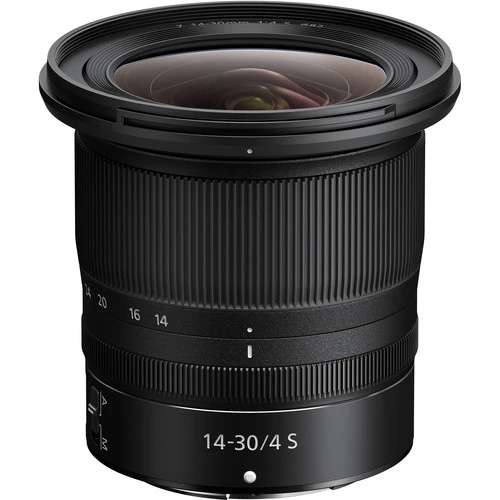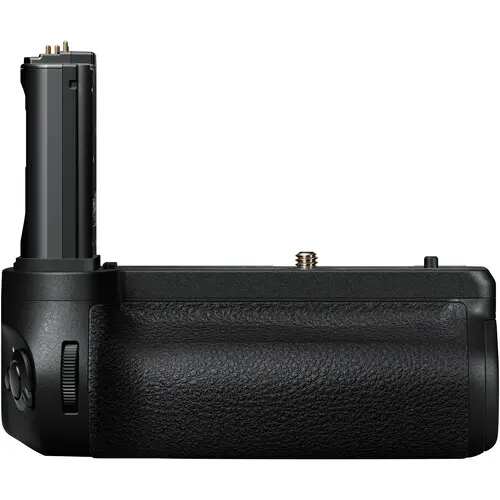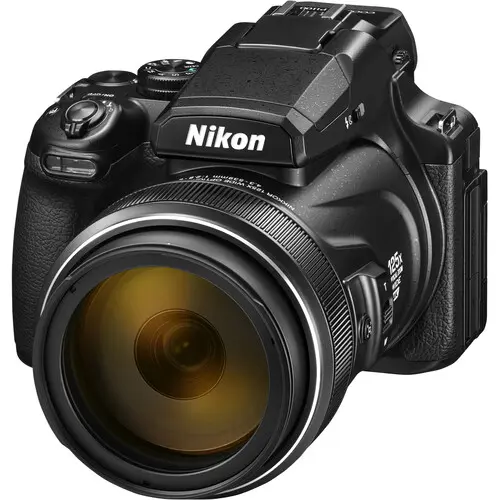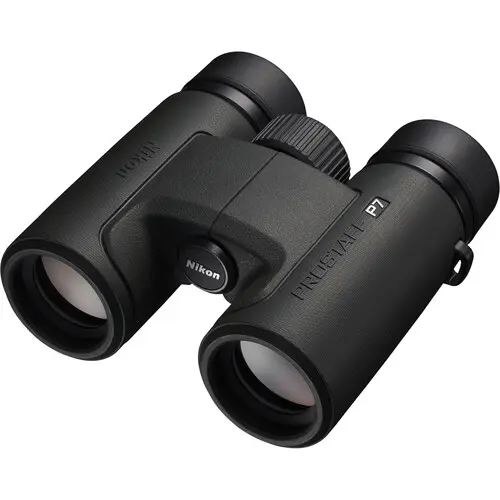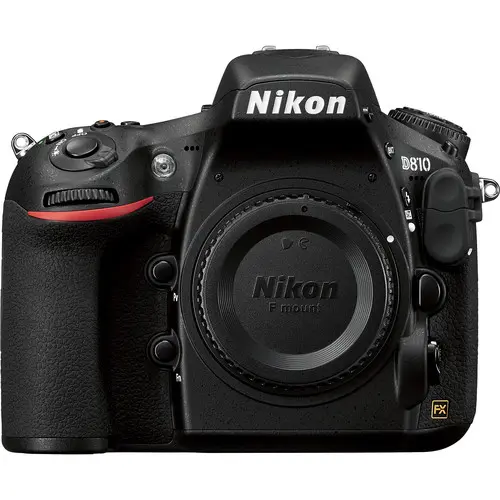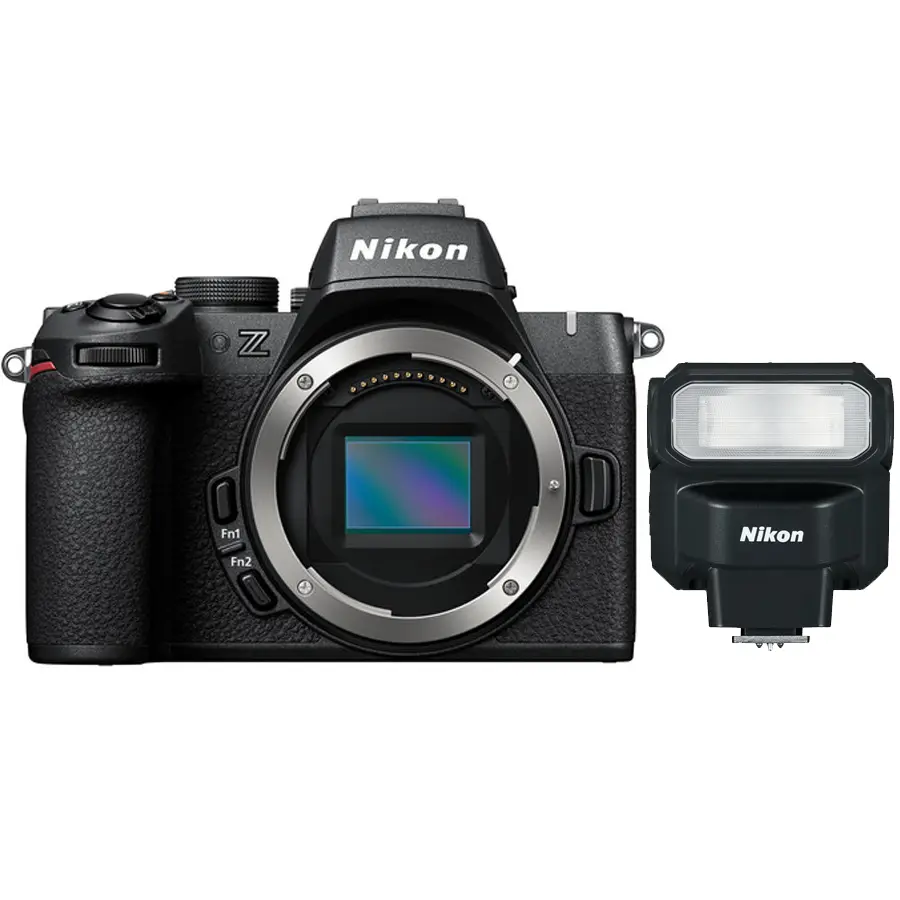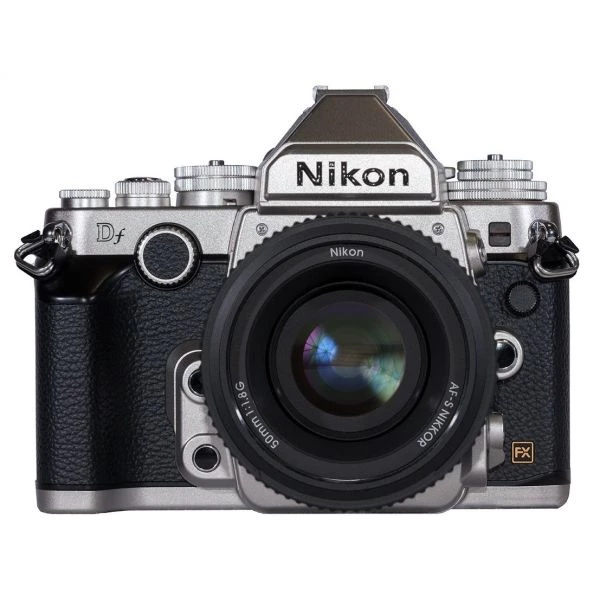Nikon D850 DSLR (Body Only)
Key Features
- 45.7MP FX-format BSI CMOS Sensor
- EXPEED 5 Image Processor
- 3.2" 2.36m-Dot Tilting Touchscreen LCD
- 4K UHD Video Recording at 30 fps
Nikon D850 Overview
Proving that speed and resolution can indeed coexist, the Nikon D850 is a multimedia DSLR that brings together robust stills capabilities along with apt movie and time-lapse recording. Revolving around a newly designed 45.7MP BSI CMOS sensor and proven EXPEED 5 image processor, the D850 is clearly distinguished by its high resolution for recording detailed imagery. The back-illuminated design of the sensor is able To acquire greater detail and clarity when working in low-light conditions, and the sensor also forgoes an optical low-pass filter for improved sharpness. Working in conjunction with the sensor is the EXPEED 5 image processor, which together afford a 7 fps continuous shooting rate for up To 51 consecutive frames, an expandable sensitivity Range from ISO 64 To 102400, and 4K UHD video recording using either a DX crop or the entire area of the full-frame sensor. An 8K time-lapse recording mode is also available, as well as additional specialized recording modes for digitizing film negatives and for focus stacking applications. Benefitting the imaging capabilities is an advanced Multi-CAM 20K 153-point AF system, which debuted with the flagship D5 and offers 99 cross-type sensors for refined focusing accuracy in a variety of lighting conditions. Checking off a number of boxes for multimedia image-makers, the D850 positions itself as not only a high-resolution DSLR but also as a camera for speed, movies, and low-light shooting needs.
Balancing the versatile imaging features, the D850 is also equally refined in its physical design. A large optical pentaprism offering a wide field of view and 0.75x magnification affords photographers a bright, clear, and realistic view for critical shooting needs. Conversely, a 3.2" 2.36m-dot LCD touchscreen is also available for live view shooting, playback, and menu navigation, and features a tilting design To suit working from high and low angles. A weather-sealed design is also employed, To suit working in a variety of environmental conditions, and the optional MB-D18 grip can be added To boost overall shooting times and continuous shooting rates. Additionally, built-in SnapBridge allows for wireless sharing of low-resolution imagery and remote live view use on a linked mobile device, and an optional WT-7a Wireless Transmitter can also be used for faster wireless transferring of files.
45.7MP FX-format BSI CMOS Sensor and EXPEED 5 Processor
A first for Nikon DSLRs, a 45.7MP BSI CMOS sensor is used for high-resolution shooting, impressive low-light quality, and fast readout speeds To benefit continuous shooting, movies, and time-lapse recording. The back-illuminated design of the sensor affords noticeably cleaner high-sensitivity output for reduced noise when working at high ISO values, up To a native ISO 25600, as well as vivid and smooth quality at sensitivities as low as ISO 64. The sensor design also omits the conventional optical low-pass filter in order To achieve the greatest sharpness and resolution from the sensor.
Benefitting the sensor is the apt EXPEED 5 image processor, which affords a wealth of speed throughout the camera system, including the ability To shoot continuously at 7 fps for up To 51 consecutive 14-bit lossless compressed raw files in a single burst. When working with the optional MB-D18 grip and EN-EL18a/b battery, this shooting rate can be increased To 9 fps, and up To 30 fps shooting is possible when working in a DX crop mode during Silent Live View.
153-Point Multi-CAM 20K Autofocus System
Complementing the rendering capabilities and speed of the image sensor is the robust Multi-CAM 20K AF system, which features 153 total phase-detection points, including 99 cross-type sensors for improved subject recognition, and 55 of the points are Selectable for greater compositional freedom. Benefitting the use of super telephoto lenses and teleconverters, 15 of the points, including nine Selectable points, are compatible with an effective aperture of f8, and all 153 points support working with effective aperture of f5.6 or brighter.
Managing the abundance of focusing points is a dedicated AF engine, which offers quick response times To benefit tracking fast and randomly moving subjects, even at the top 7 fps shooting rate. The AF engine also contributes To enhanced focusing sensitivity, with all points capable of focusing -3 EV for working in very dark, low-contrast situations.
4K UHD Video Recording and 8K Time-Lapse
Utilizing the sensor and processor attributes for more than just still imagery, the D850 is also a more-than-capable multimedia camera. Video recording is possible at 4K UHD (3840 x 2160) using either the full-frame area or a DX crop area in 30p, 25, or 24p frame rates. Full HD 1080p video recording is also supported at up To 120p for slow motion playback, and video files can be saved To the in-camera memory cards or as an uncompressed file To an optional external recorder via HDMI out.
Benefitting video recording, a dedicated power aperture button (Pv) makes it possible To achieve smooth, continuous exposure transitions when switching from light To dark areas, and Auto ISO can also be used To maintain a consistent brightness when working in changing lighting situations. Audio recording can be handled using the built-in stereo microphone or an optional external mic can be added via the 3.5mm stereo jack for greater control over quality, and live monitoring is possible via the headphone jack.
The D850 also blends both still and video capabilities with the ability To produce 8K time-lapses, which can be output as 4K movie files directly from the camera. This system also makes use of a silent interval timer, which produces no shutter noise, does not contribute To wear on the shutter mechanism, and is energy efficient To maximize battery life.
Body Design
- A large 3.2" 2.359m-dot LCD screen is available for bright, clear, and vivid image playback and live view shooting. The screen has a tilting design To benefit working from both high and low angles, and it is also a touchscreen for more intuitive operation, navigation, and settings control.
- The bright optical pentaprism viewfinder offers a large 0.75x magnification and a wide field of view for comfortable and accurate use.
- Configured with one XQD memory card slot and one SD memory card slot, which allows you To extend file saving capabilities by permitting overflow recording, in-camera file-duplicating, or the ability To segregate raw and JPEG files between the two cards.
- A robust magnesium alloy chassis is both dust- and weather-resistant To benefit working in harsh climates and inclement conditions.
- The ergonomic grip and overall form factor is shaped To benefit handling for extended periods of time and is further accentuated by an anti-slip material and a joystick for seamless settings and focus point Selection. Additionally, most of the rear buttons are illuminated for greater visibility when working in dim lighting conditions.
- The included EN-EL15a rechargeable lithium-ion battery is CIPA-rated To last for approximately 1840 shots per charge. If paired with the optional MB-D18 grip and EN-EL18a/b battery, you can record approximately 5140 shots per charge.
Scene Recognition System and Exposure Metering
The intelligent Scene Recognition System with 3D Color Matrix Metering III utilizes a 180,000-pixel RGB sensor To evaluate and analyze all aspects within a scene, including brightness, contrast, subject distance, and the scene colors, To quickly determine an accurate exposure and white balance setting To best render the scene at hand. The information gathered is also checked against onboard reference images To ensure consistency from image To image in regard To exposure, white balance, i-TTL flash settings, and subject-tracking AF performance.
Other Camera Features
- Built-in SnapBridge connectivity To enable seamless transfer of low-resolution imagery as well as remote shooting capabilities. BLE (Bluetooth Low Energy) and Wi-Fi enables communication between the camera and a smart device and, additionally, the mobile device can remotely trigger the shutter and display a live view image from the camera To enable working from a distance.
- Faster wireless transfer is possible using the optional WT-7a Wireless Transmitter.
- A Negative Digitizer mode is specifically designed for photographing film negatives and slides To convert them To high-resolution digital files. This mode is intended To be used with the optional AF-S Micro NIKKOR 60mm f2.8G ED lens and the ES-2 Slide Copying Adapter.
- Automatic Focus Shift mode benefits working with focus stacking techniques by automatically recording a series of images at up To 10 different focus steps. Up To 300 individual frames can be recorded within these 10 steps, with the D850 automatically shifting focus between each shot To achieve an extended depth of field. The sequential images will be saved within a unique folder on the memory card in order To keep each series of exposures segregated for a faster and easier post-production workflow.
- In-camera shooting in the 1:1 square format is possible, and the viewfinder will be automatically shaded during shooting in order To aid in more accurate composition.
- Automatic AF Fine Tune can be used To ensure accurate focusing capabilities and To limit back- or front-focusing.
- Raw files can be recorded in three separate sizes for expedited post-production, and in-camera raw file batch processing is also possible.
- The D850 is compatible with the radio-controlled Advanced Wireless Lighting system, which permits working with the optional WR-R10 Controller and WR-A10 Receiver, along with the SB-5000, for intuitive, controllable wireless flash shooting.
Nikon EN-EL15b Overview
Power Select Nikon cameras with this EN-EL15b Rechargeable Lithium-Ion Battery, which serves as a spare or replacement for the one provided with the camera. It is designed to offer long life and consistent power, and can be charged or discharged at any time without developing memory effects.
When used with the Z 7 and Z 6, the battery is compatible with the MH-25 and MH-25a chargers, or can be charged in-camera using the EH-7P Charging AC Adapter.
Camera Compatibility
Z 7
Z 6
D850
D810
D810A
D800E
D800
D750
D610
D500
D7500
D7200
D7100
D7000
Nikon Nikkor Z 24-70mm f/4 S Overview
Key Features
- Z-Mount Lens/FX Format
- Aperture Range: f/4 to f/22
- Aspherical Extra-Low Dispersion Element
- Three Aspherical Elements
- Nano Crystal & Super Integrated Coatings
- Stepping Motor AF System
- Programmable Control Ring
- Weather-Sealed Design, Fluorine Coating
- Rounded 7-Blade Diaphragm
- Retractable Design
Covering a useful Range of focal lengths, the Nikkor Z 24-70mm f/4 S is a versatile zoom, spanning wide-angle to portrait-length perspectives. Its constant f/4 maximum aperture maintains a consistent exposure throughout the zoom Range and also helps to realize a more compact and lightweight alternative to an f/2.8 zoom. In regard to the optical design, a unique aspherical extra-low dispersion element, in addition to three aspherical elements, is used to help reduce chromatic aberrations and distortions throughout the zoom Range in order to achieve high image sharpness and clarity. Both Nano Crystal and Super Integrated Coatings have also been applied to control flare and ghosting for greater contrast and color rendering in bright and backlit conditions.
Complementing the optics, a stepping motor provides quick, quiet, and precise autofocus performance along with full-time manual focus override to suit both stills and video applications. A programmable control ring can be set for intuitive adjustment over a variety of camera and exposure settings. Additionally, the lens has a button-less retractable barrel to realize a more compact form factor when not in use.
- Standard zoom covers a wide-angle to portrait-length Range and is designed for FX-format Z-mount mirrorless cameras.
- Constant f/4 maximum aperture affords consistent performance throughout the zoom Range and also contributes to the relatively lightweight design and compact form factor.
- A unique aspherical extra-low dispersion element is incorporated into the optical design, along with three additional aspherical elements, to greatly reduce chromatic and spherical aberrations, distortion, coma (comatic aberration), and flare for consistent edge-to-edge sharpness and illumination.
- A Nano Crystal Coat, along with a Super Integrated Coating, has been applied to lens elements to minimize surface and internal reflections for a marked reduction in lens flare and ghosting.
- Stepping motor delivers impressively smooth, quiet, and fast autofocus performance that is well-suited to both stills and video applications. Full-time manual focus override is also possible and an internal focusing design is used, where only the internal lens groups are moved during focusing, to maintain the overall length of the lens during use and to promote faster focusing speeds.
- Programmable Control Ring is, by default, set to adjust manual focus, but can also be used to control aperture or exposure compensation.
- Specialized electromagnetic aperture mechanism provides greater exposure control stability that is especially beneficial when working with fast continuous shooting rates.
- Rounded seven-blade diaphragm promotes a pleasing out of focus quality that benefits the use of shallow depth of field and Selective focus techniques.
- Exposed elements feature a fluorine coating that affords protection to the optical system against dust, grease, and water droplets.
- Dust- and moisture-resistant lens barrel benefits the lens' use in inclement conditions.
- Button-less retractable design maintains a compact form factor when the lens is not in use.
Nikon Nikkor Z 35mm f1.8 S Overview
Key Features
- Z-Mount Lens/FX Format
- Aperture Range: f/1.8 to f/16
- Two ED and Three Aspherical Elements
- Nano Crystal & Super Integrated Coatings
- Stepping Motor AF System
- Programmable Control Ring
- Weather-Sealed Construction
- Rounded 9-Blade Diaphragm
A favored focal length for everything from landscape To street shooting, the Nikkor Z 35mm f1.8 S is a prime wide-angle lens characterized by its versatility and bright f1.8 maximum aperture. Furthering its merits, the optical design features two extra-low dispersion elements and three aspherical elements, which reduce a variety of aberrations and distortion To produce imagery with high sharpness, clarity, and accurate color rendering. Both Nano Crystal and Super Integrated Coatings are used, too, To suppress flare and ghosting for greater color fidelity and higher contrast.
Benefitting the optics, a stepping motor provides quick, quiet, and precise autofocus performance along with full-time manual focus override To suit both stills and video applications. Additionally, a programmable control ring can be set for intuitive adjustment over a variety of camera and exposure settings.
- Prime wide-angle lens is designed for FX-format Z-mount mirrorless cameras.
- Bright f1.8 maximum aperture suits working in difficult lighting conditions and also offers increased control over depth of field for isolating subjects and working with Selective focus.
- Three aspherical elements are used To reduce spherical aberrations and distortion in order To realize sharp imagery with accurate rendering.
- Two extra-low dispersion elements greatly reduce color fringing and chromatic aberrations in order To produce greater clarity and color rendering.
- A Nano Crystal Coat, along with a Super Integrated Coating, has been applied To lens elements To minimize surface and internal reflections for a marked reduction in lens flare and ghosting.
- Stepping motor delivers impressively smooth, quiet, and fast autofocus performance that is well-suited To both stills and video applications. Full-time manual focus override is also possible and an internal focusing design is used, where only the internal lens groups are moved during focusing, To maintain the overall length of the lens during use and To promote faster focusing speeds.
- Programmable Control Ring is, by default, set To adjust manual focus, but can also be used To control aperture or exposure compensation.
- Specialized electromagnetic aperture mechanism provides greater exposure control stability that is especially beneficial when working with fast continuous shooting rates.
- Rounded nine-blade diaphragm promotes a pleasing out of focus quality that benefits the use of shallow depth of field and Selective focus techniques.
- Dust- and moisture-resistant lens barrel benefits the lens' use in inclement conditions.

Nikon Nikkor Z 85mm f1.8 S Overview
Key Features
- Z-Mount Lens/FX Format
- Aperture Range: f/1.8 to f/16
- Two Extra-Low Dispersion Elements
- Nano Crystal & Super Integrated Coatings
- Multi-Focus Stepping Motor AF System
- Programmable Control Ring
- Weather-Sealed Construction
- Rounded 9-Blade Diaphragm
Popular for portraiture, the NIKKOR Z 85mm f/1.8 S from Nikon is a short-telephoto prime characterized by its flattering focal length and bright f/1.8 design. The maximum aperture strikes a balance between size, weight, and speed, offering suitable speed for working in difficult lighting yet remaining sleek enough for handheld use. In terms of optics, two extra-low dispersion elements are featured, and help to reduce color fringing and chromatic aberrations in order to achieve high clarity and color fidelity. Also, both Nano Crystal and Super Integrated Coatings are used to suppress flare and ghosting for greater color fidelity and higher contrast.
Complementing the optical design, a multi-focus system, which employs two stepping motors, helps to realize impressively fast, accurate, and quiet focus performance, along with full-time manual focus override, to suit both stills and video needs. Additionally, a programmable control ring can be set for intuitive adjustment over a variety of camera and exposure settings.
- Prime portrait-length lens is designed for FX-format Z-mount mirrorless cameras.
- Bright f/1.8 maximum aperture suits working in difficult lighting conditions and also offers increased control over depth of field for isolating subjects and working with selective focus.
- Two extra-low dispersion elements greatly reduce color fringing and chromatic aberrations in order to produce greater clarity and color rendering.
- A Nano Crystal Coat, along with a Super Integrated Coating, has been applied to lens elements to minimize surface and internal reflections for a marked reduction in lens flare and ghosting.
- Multi-focus system incorporates two separate AF drive units, which are synchronized, to deliver especially fast and accurate focusing performance. This system uses stepping motors, which offer impressively smooth and quiet autofocus qualities, that are well-suited to both stills and video applications. Full-time manual focus override is also possible and an internal focusing design is used, where only the internal lens groups are moved during focusing, to maintain the overall length of the lens during use and to promote faster focusing speeds.
- Programmable Control Ring is, by default, set to adjust manual focus, but can also be used to control aperture or exposure compensation.
- Specialized electromagnetic aperture mechanism provides greater exposure control stability that is especially beneficial when working with fast continuous shooting rates.
- Dust- and moisture-resistant lens barrel benefits the lens' use in inclement conditions.

Nikon D6 Overview
The peak of Nikon DSLR lineup, the D6 is a no-holds-barred camera with a focus on speed, performance, reliability, and precision. Adept in both photo and video realms, the D6 revolves around a 20.8MP FX-format sensor and an EXPEED 6 image processor that enables an impressive 14 fps continuous shooting rate, a native sensitivity Range from ISO 100-102400 (expandable up To ISO 3280000), and UHD 4K video recording at 30 fps. When working with stills, a revised high-density Multi-CAM 37K autofocus system features 105 cross-type points that improve focusing precision and speed, and with 1.6x greater frame coverage, the need To recompose while shooting is greatly reduced. This focusing system also works with 17 customizable Group Area AF patterns To suit working in cluttered or busy scenarios or with fast-moving subjects.
As Nikon flagship DSLR, the D6 is, of course, a tough camera, too. Its magnesium alloy construction pairs with extensive weather sealing To resist dust and moisture, and a reinforced shutter mechanism has been tested for 400,000 shutter cycles. for viewing, there is a large pentaprism optical viewfinder with 0.72x-magnification as well as a rear 3.2" 2.36m-dot touchscreen LCD. Additionally, the body design incorporates dual CFexpress Type B memory card slots, which offer flexible file saving capabilities, and internal Wi-Fi and Bluetooth also benefit file saving needs as well as afford remote shooting control. for more robust connectivity, the D6 supports wired and wireless LAN connections, too. And, built-in GPS is featured, as well, for in-camera geotagging applications. In familiar form, too, the D6 also has a variety of configurable Function buttons across the body and an integrated vertical grip supports working in both horizontal and vertical shooting orientations.
20.8MP FX-format CMOS Sensor and EXPEED 6 Image Processor
The FX-format 20.8MP CMOS sensor is paired with the EXPEED 6 image processor To offer a proven mixture of high sensitivity, nuanced image quality, and fast overall performance. At native values, a sensitivity Range from ISO 100-102400 permits working in a broad array of lighting conditions, an can be further expanded To ISO 50-3280000 (Lo 1 To Hi 5) To handle the most challenging of situations. The mixture of resolution and sensor size also contributes To clean image quality and smooth color transitions with reduced noise throughout the sensitivity Range.
In addition To benefitting image quality, the EXPEED 6 processor also affords a wealth of speed throughout the camera system, including a top continuous shooting rate of 14 fps for up To 200 consecutive frames. for sound-sensitive situations, a silent 10.5 fps rate can be used for discreet shooting and, if choosing To work in a lower resolution and in live view, up To 60 fps shooting is possible at 2MP or 30 fps shooting at 8MP.
105-Point All Cross-Type Multi-CAM 37K Autofocus System
Dubbed "the most powerful AF in Nikon history," the Multi-CAM 37K autofocus system uses an intelligent array of 105 all cross-type points To quickly and accurately achieve focus across the frame and in a variety of lighting conditions. This high-density system allows photographers To set focus almost anywhere within the frame in order To avoid recomposing. This unique design reduces the area of non-AF-sensitive areas in order To make the effective coverage 1.6x greater than in previous models, which allows for more accurate and faster focusing across the frame, with both still and moving subjects. When working with moving subjects, 17 custom Group Area AF settings can be used To set and maintain focus on subjects featuring busy backgrounds or fast subject movement. Benefitting the use of super telephoto lenses and teleconverters, 15 of the points are compatible with an effective aperture of f8 and all 1053 points support working with effective apertures of f5.6 or brighter.
Complementing the abundance of focusing points is a dedicated AF engine, which offers quick response times To benefit tracking fast and randomly moving subjects, even at the top 14 fps shooting rate. The AF engine also contributes To enhanced focusing sensitivity, with the ability To focus at -4.5 EV for working in very dark, low-contrast situations.
Furthering the versatility of the focusing system, seven different AF-area modes can be Selected To support varying types of subject matter:
- Single-Point AF: The camera uses a single point To find focus.
- Dynamic-Area AF: Available with 9, 25, 49, or 105-point Selections, this mode uses a primary single focus point To lock onto focus, and then makes use of the surrounding points for maintaining focus while tracking erratically-moving subjects.
- Group-Area AF: This mode treats smaller groups of AF points as a single point for a wider field of recognition and is well-suited To tracking faces or other detailed subjects.
- 3D-Tracking: Using a subject color information, this mode utilizes all 105 points To maintain focus on a moving subject while half-pressing the shutter button.
- Auto-Area AF: This mode makes use of all 105 points To quickly identify the main subject, and then prioritizes recognized faces as portrait subjects in any AF servo mode.
In addition To the Range of AF-area modes, an AF lock-on function can also be used To improve subject tracking performance and can be adjusted by two parameterquick or delayed blocked shot AF response and erratic or steady subject movement. By configuring these settings, the AF performance can be optimized To handle a wide variety of subject movement types.
Lastly, a unique auto AF fine-tune function can be employed To ensure the best possible focus for each mounted lens. Rather than relying on photographing distance charts, this function lets you achieve precise focus manually in live view, and then have the AF system calibrate itself To the fine-tuned focus position in order To alleviate front- and back-focusing issues.
4K UHD Video Recording
Taking notice of multimedia image-maker needs, the D6 incorporates adept video recording capabilities. Able To record UHD 4K at 30, 25, and 24 fps frame rates, Full HD and HD recording is also supported, along with the ability To save movie files To the in-camera memory cards or as an uncompressed file To an optional external recorder via HDMI out.
As with still shooting, the wide Range of sensitivities is available for recording in low- and bright-light conditions, ranging from expanded ISO 100-3280000, and sensitivity values are manually adjustable via the dedicated movie-shooting menu. Also, a video-optimized Flat Picture Control mode can be used during recording To flatten the overall contrast curve for more control during post-production and color grading.
In regard To handling, a dedicated power aperture button (Pv) makes it possible To achieve smooth, continuous exposure transitions when switching from light To dark areas, and Auto ISO can also be used To maintain consistent brightness when working in changing light situations. Audio recording can be handled using the built-in stereo microphone or an optional external mic can be added via the 3.5mm stereo jack for greater control over quality. Regardless if using the in-camera mic or an external mic, audio levels can be adjusted in 20 increments and live monitoring is possible via the headphone jack, which afford 30 different volume levels for playback.
In addition To straight movie recording, time-lapse recording, for up To 9999 consecutive frames shot over the course of up To one week, is also possible with up To UHD 4K at 30 fps output from the camera.
Body Design and Connectivity
- A large 3.2" rear LCD monitor features a high 2.36m-dot resolution for clear, vivid playback and live view shooting. The monitor is also a touchscreen for more intuitive menu navigation and settings control. The touchscreen is also usable while shooting, giving you the ability To choose a focus point or an area To set the white balance from. The screen can also be used as a keyboard for quickly entering notes, copyright info, or IPTC metadata.
- The bright 0.72x optical pentaprism viewfinder covers 100% of the FX frame for framing accuracy. A detachable DK-27 Eyepiece Adapter also lets you attach a rain cover directly To the viewfinder for more comfortable shooting in wet conditions.
- Configured with two CFexpress Type B/XQD memory card slots, allowing you To extend file saving capabilities by permitting overflow recording, in-camera file duplicating, or the ability To segregate raw and JPEG files between the two cards.
- The familiar body design incorporates a vertical grip that is designed To be equally as comfortable and efficient when shooting in the vertical or horizontal orientation.
- Advanced customization options help To create an intuitive and efficient way of working with the camera, including configuring re-callable preset camera settings, such as distinct AF settings, for immediate use and quick switching depending on the shooting situation. There are 14 different buttons that can be personalized with up To 46 different functions for easier access To the settings you need and an intuitive i Menu, accessible via the i button, provides a shortcut To the most oft-used camera settings, which can be configured To your own needs. Additionally, save up To four custom shooting combinations from the Custom Settings Menu and up To four from the Photo Shooting Menu for faster switching between shooting settings.
- A robust magnesium alloy chassis is both dust- and weather-resistant To benefit working in harsh climates and inclement conditions.
- The ergonomic grip and overall form factor are shaped To benefit handling for extended periods of time and are further accentuated by anti-slip, textured joysticks and easy-to-open card slot covers. Additionally, most of the rear buttons on the rear of the camera are illuminated for greater visibility when working in dim lighting conditions.
- An electronic front-curtain shutter helps To minimize mechanical vibrations in order To better ensure sharpness during long exposures.
- The high-precision shutter mechanism has been tested for a long lifespan of 400,000 actuations.
- The included EN-EL18c rechargeable lithium-ion battery is CIPA-rated To last for approximately 3580 shots per charge in single-frame release modes.
- Built-in Wi-Fi and Bluetooth work in conjunction with Snapbridge for seamless wireless file transferring and remote camera control from a mobile device.
- Integrated GPS module enables in-camera file geotagging.
- The built-in wired LAN function of 1000 Base-T (Gigabit) standard enables high-speed, seamless transferring of still imagery and movie files for expediting an entire post-production workflow. for more robust wireless file transferring, the D6 is also compatible with the optional WT-6A Wireless Transmitter.
Scene Recognition System and Exposure Metering
The intelligent Scene Recognition System with 3D Color Matrix Metering III utilizes a 180,000-pixel RGB sensor To evaluate and analyze all aspects within a scene, including brightness, contrast, subject distance, and the scene colors, To quickly determine an accurate exposure and white balance setting To best render the scene at hand. The information gathered is also checked against onboard reference images To ensure consistency from image To image in regard To exposure, white balance, i-TTL flash settings, and subject-tracking AF performance.
Other Camera Features
- Focus Shift Mode benefits working with focus stacking techniques by automatically recording a series of images at different focus steps. Up To 300 individual frames can be recorded within these steps, with the D6 automatically shifting focus between each shot To achieve an extended depth of field. The sequential images will be saved within a unique folder on the memory card in order To keep each series of exposures segregated for a faster and easier post-production workflow.
- for long exposure shooting, specific exposure times longer than 30 seconds can be set for more accurate results. Configured in the custom settings menu, and usable in the M mode, Selectable times are available from 60 sec up To 900 sec.
- Reducing post-production times, there are 20 unique Creative Picture Controls, which can be previewed in real time, and used with both photos and videos, To adjust the look and feel of imagery.
- Multiple exposures can be made in the traditional sense, of sequentially shooting consecutive frames over one another, or can be made using any photo previously shot with the camera via the Retouch menu.
Nikon Coolpix Digital Camera A1000
Key Features
- 16MP 1/2.3" BSI CMOS Sensor
- NIKKOR Super ED 35x Optical Zoom Lens
- 24-840mm (35mm Equivalent)
- 1.166m-Dot Electronic Viewfinder
Nikon A1000 Overview
Pocketable and versatile, the black Nikon COOLPIX A1000 is a sleek point-and-shoot offering flexible imaging capabilities and a well-rounded physical design. A 16MP BSI CMOS sensor and EXPEED image processing yield high-resolution, well-defined imagery with an ISO 100-6400 sensitivity Range and a fast 10-fps shooting rate for photographing moving subjects. UHD 4K video recording is also supported at 30p, along with Full HD recording at up to 60p, and still frames can be pulled from 4K footage for isolating fast-moving moments. Complementing the imaging assets is the impressive 35x Zoom-NIKKOR ED lens, which covers a 24-840mm equivalent focal length Range to suit shooting in nearly any situation. Lens-shift VR benefits stills shooting at long focal lengths and with slower shutter speeds, and compensates for the effects of camera shake for up to three stops. Additionally, the A1000 is further characterized by its high-resolution 1.166m-dot electronic viewfinder for eye-level viewing, a rear 3.0" 1.036m-dot tilting touchscreen LCD, and built-in Wi-Fi and Bluetooth for wireless sharing and remote control.
16MP 1/2.3" BSI CMOS Sensor
A high-resolution 16MP 1/2.3" BSI CMOS sensor affords impressive image quality with enhanced sensitivity, from ISO 100-6400, to benefit working in difficult lighting conditions, along with the ability to record in the NRW raw format for expanded post-production capabilities. The sensor also affords quick performance throughout the camera system, including a continuous shooting rate of up to 10 fps.
Zoom-NIKKOR ED 35x Zoom Lens
A wide-ranging NIKKOR 35x optical zoom lens provides a 24-840mm equivalent focal length Range that covers wide-angle to super telephoto perspectives, and its Range can effectively be doubled through the use of Dynamic Fine Zoom for a total 70x zoom magnification. Lens-shift Vibration Reduction balances this awesome length by compensating for the effects of up to three stops of camera shake for sharper handheld shooting. Additionally, the lens' optical design incorporates extra-low dispersion glass to minimize chromatic aberrations and color fringing throughout the zoom Range for cleaner, clearer image quality.
UHD 4K Video Recording
In addition to stills recording, UHD 4K video recording is supported at 30p, as well as Full HD recording up to 60p. for steadying recording, Hybrid Vibration Reduction can be used to suppress the effects of camera shake that occur while moving when recording. Additionally, individual frames from 4K videos can also be saved as 8MP stills to serve as a viable means for photographing fast-moving subjects.
Body Design and Built-In Wi-Fi
- Sleek, pocketable form factor is ideal for everyday shooting.
- High-resolution 1.166m-dot electronic viewfinder provides bright, clear eye-level viewing, which is especially beneficial when working in bright conditions.
- A 3.0" 1.036m-dot touchscreen LCD is an intuitive means for live view shooting, playback, and menu navigation, and it has a tilting design to benefit working from high, low, and front-facing angles.
- Built-in Wi-Fi and Bluetooth Low Energy work in conjunction with Nikon's SnapBridge system for connecting the camera with a mobile device in order to wirelessly share images between devices as well as remotely control the camera.
- Snap-Back Zoom Button lets you quickly zoom out from a super telephoto position to regain perspective of the entire scene and reacquire your subject. This button can also be customized to activate manual focus, aperture, ISO, exposure compensation, or white balance adjustments.
- EN-EL12 rechargeable lithium-ion battery offers approximately 250 shots per charge.
- An HDMI port permits connecting the camera directly to an HDTV for high-resolution playback.
- Built-in pop-up flash can be used for additional illumination when working in difficult lighting conditions.
Other Camera Features
- Target Finding AF automatically assesses the scene, recognizes intended subjects, and then adjusts the AF area according to the subject's size to better ensure clearly focused images.
- The contrast-detection autofocus system and Subject Tracking function also work to maintain focus on moving subjects.
- Smart Portrait System utilizes a series of automatic functions, including In-Camera Red-Eye Fix, Face-Priority AF, Face Priority AE, Smile Mode, Blink Warning, Skin Softening, and D-Lighting to produce better portraits.
- Scene Auto Selector automatically recognizes the type of scene you are photographing and Selects one of six commonly used scene modes to alleviate the need to manually Select your mode.
- Multiple Exposure Lighten records multiple shots into one frame to creatively capture moving subjects, such as fireworks.
- Creative Mode options let you produce artistically-refined imagery in-camera.
- Scene Modes: Backlighting, Beach, Close Up, Dusk/Dawn, Easy Panorama, Fireworks Show, Food, Landscape, Multiple Exposure Lighten, Night Landscape, Night Portrait, Party/Indoor, Pet Portrait, Portrait, Scene Auto Selector, Selective Color, Smart Portrait, Snow, Soft, Sports, Sunset, and Superlapse Movie.
- In-camera image editing modes: Copy, D-Lighting, Filter Effects, Quick Effects, Quick Retouch, Skin Softening, and Small Picture.
- Language support: Arabic, Bengali, Bulgarian, Chinese (Simplified and Traditional), Czech, Danish, Dutch, English, Finnish, French, German, Greek, Hindi, Hungarian, Indonesian, Italian, Japanese, Korean, Marathi, Norwegian, Persian, Polish, Portuguese (European and Brazilian), Romanian, Russian, Serbian, Spanish, Swedish, Tamil, Telugu, Thai, Turkish, Ukrainian, Vietnamese.
Nikon D7500 Overview
Key Features
- 20.9MP DX-Format CMOS Sensor
- EXPEED 5 Image Processor
- 3.2" 922k-Dot Tilting Touchscreen LCD
- 4K UHD Video Recording at 30 fps
- Multi-CAM 3500FX II 51-Point AF System
- Native ISO 51200, Expanded ISO 1,640,000
- 8 fps Shooting for Up to 100 Frames
- SnapBridge Bluetooth and Wi-Fi
- 180k-Pixel RGB Sensor and Group Area AF
Designed as a true all-arounder, the Nikon D7500 is a DX-format DSLR offering a versatile feature-set to appeal to photographers and videographers alike. Based on a 20.9MP CMOS sensor and EXPEED 5 image processor, this multimedia maven avails an 8 fps continuous shooting rate for up to 100 consecutive JPEGS, a native sensitivity range to ISO 51,200 that can be expanded up to ISO 1,640,000, and 4K UHD video and time-lapse recording capabilities. Complementing the imaging capabilities is a 51-point Multi-CAM 3500FX II autofocus system, which features 15 cross-type points for fast performance and accurate subject tracking capabilities in a variety of lighting conditions.
Balancing the performance attributes, the D7500 is also characterized by its sleek profile and monocoque construction that is comfortable and easy to handle. This physical design is also fully weather-sealed to permit working in harsh environmental conditions. In addition to the pentaprism optical viewfinder, a rear 3.2" 922k-dot touchscreen is also featured, and has a tilting design to benefit working from high and low shooting angles. Additionally, SnapBridge Bluetooth and Wi-Fi permit wireless transferring of photos and movies and remote control over the camera from linked mobile devices.
20.9MP DX-Format CMOS Sensor and EXPEED 5 Image Processor
The DX-format 20.9MP CMOS sensor is paired with the EXPEED 5 image processor to provide an esteemed mixture of high sensitivity, nuanced image quality, and fast overall performance. At native values, a sensitivity range from ISO 100-51200 permits working in a broad array of lighting conditions, and can be further expanded to ISO 50-1640000 (Lo 1 to Hi 5) to handle the most challenging of situations. The mixture of resolution and sensor size also contributes to clean image quality and smooth color transitions with reduced noise throughout the sensitivity range.
In addition to benefitting image quality, the EXPEED 5 processor also affords a wealth of speed throughout the camera system, including a top continuous shooting rate of 8 fps with full-time autofocus and exposure metering. Up to 100 JPEGs or 50 14-bit lossless compressed NEF files can be recorded in a single burst.
4K UHD Video Recording
Capable of recording more than just stills, the D7500 supports 4K UHD video recording at 30, 25, and 24 fps frame rates and Full HD/HD recording at up to 60 fps, along with the ability to save movie files to the in-camera memory cards or as an uncompressed file, with 4:2:2 sampling, to an optional external recorder via HDMI out. For maintained quality and versatility in how your movies look, three image area options are available:
- 4K UHD movie image format is an area that provides a 1.5x increase in the effective focal length of the lens in use and is reserved for 4K 3840 x 2160 recording.
- 1.3x-based movie image area provides a 1.3x crop of the DX sensor, and is used for recording Full HD and HD video.
- DX-based movie image format utilizes the full width of the DX-format sensor, and is used to record Full HD 1920 x 1080 and HD 1280 x 720 video. This setting is well-suited for shallow depth of field effects and provides the widest field of view.
As with still shooting, the wide range of sensitivities is available for recording in low- and bright-light conditions, ranging from expanded ISO 100-1640000, and sensitivity values are manually adjustable via the dedicated movie-shooting menu. Also, a video-optimized Flat Picture Control mode can be used during recording to flatten the overall contrast curve for more control during post-production and color grading.
Benefitting handheld shooting, an Electronic Vibration Reduction feature can be used during Full HD and HD recording, which minimizes the appearance of camera shake across three axes to control horizontal, vertical, and rotational movements. Additionally, Active D-Lighting can also be employed during Full HD/HD shooting to preserve highlight and shadow detail when working in high-contrast situations.
In regard to handling, a dedicated power aperture button (Pv) makes it possible to achieve smooth, continuous exposure transitions when switching from light to dark areas and Auto ISO can also be used to maintain consistent brightness when working in changing light situations. Audio recording can be handled using the built-in stereo microphone or an optional external mic can be added via the 3.5mm stereo jack for greater control over quality. Regardless if using the in-camera mic or an external mic, audio levels can be adjusted in 20 increments and live monitoring is possible via the headphone jack.
In addition to straight movie recording, time-lapse recording, for up to 9999 consecutive frames shot over the course of up to one week, is also possible with up to 4K UHD/30p output from the camera.
51-Point Multi-CAM 3500FX II Autofocus System
Supporting the imaging capabilities of the D7500 is an apt autofocus system that employs up to 51 distinct points, with options available to use 9, 21, or all 51 points depending on the situation, with AF detection sensitivity down to -3 EV. 15 cross-type points are also integrated within this array to provide even greater accuracy to centrally-located subjects. Benefitting the use of telephoto lenses and teleconverters, the center-most point is also sensitive down to an aperture value of f/8. 3D Tracking, a part of the intelligent Scene Recognition System, also works to benefit maintained focusing on moving subjects for greater accuracy when shooting at high continuous shooting speeds. Furthermore, Single-point AF, Dynamic-area AF (with 9, 21, or 51 points selectable), 3D-tracking (using all 51 points), and Auto-area AF modes are also available, as well as Group-Area AF that treats smaller groups of AF points as a single point for a wider field of recognition, and is well-suited to tracking faces or other detailed subjects.
When working in live view, for either still or movie shooting, a contrast-based AF system is employed to acquire focus precisely and can function in continuous, full-time servo mode to better-suit working with moving subjects.
Body Design
- A large 3.2" 922k-dot touchscreen is available for intuitive live view shooting and playback control, and it features a tilting design to benefit working from high and low shooting angles.
- A bright pentaprism optical viewfinder offers 100% frame coverage and a 0.94x magnification for clear, realistic viewing in any lighting condition.
- The monocoque-type carbon-fiber construction is lightweight, durable, and incorporates a deep right hand grip for comfortable and stable handling, making it especially suitable for all-day shooting with longer zooms or telephoto lenses.
- Weather-sealed design benefits working in trying environmental conditions.
- Shutter unit has been tested for up to 150,000 cycles for long-lasting use and an integrated shutter monitor automatically calculates the duration between front and rear curtain movements with each exposure to automatically correct for any variances.
- Built-in pop-up flash is available for additional illumination when working in low-light conditions. A hot shoe can also be used in conjunction with an optional external Speedlight, and, if used with the optional WR-R10 Wireless Remote Controller, the camera can control up to three groups of SB-5000 Speedlights via radio.
- The included EN-EL15a rechargeable lithium-ion battery is CIPA-rated to last for approximately 950 shots per charge.
SnapBridge Bluetooth and Wi-Fi
Supporting a wealth of sharing and tagging possibilities, the D7500 features built-in SnapBridge connectivity to enable seamless transfer of imagery as well as remote shooting capabilities. BLE (Bluetooth Low Energy) and Wi-Fi enables communication between the camera and a smart device. Additionally, the mobile device can remotely trigger the shutter and display a live view image from the camera to enable working from a distance.
Scene Recognition System and Exposure Metering
The intelligent Scene Recognition System with 3D Color Matrix Metering III utilizes a 180k-pixel RGB sensor to evaluate and analyze all aspects within a scene, including brightness, contrast, subject distance, and the scene colors, to quickly determine an accurate exposure and white balance setting to best render the scene at hand. The information gathered is also checked against onboard reference images to ensure consistency from image to image in regard to exposure, white balance, i-TTL flash settings, and subject-tracking AF performance.
Other Camera Features
- RAW (NEF) files can be recorded as lossless compressed or compressed at either 12 or 14-bit depth.
- Automated exposure bracketing is possible for up to 9 frames with 1/3 or 1/2 EV steps between each frame.
- Active D-Lighting helps to preserve both highlight and shadow details when working in contrast-rich scenarios, such as backlit lighting. Utilizing the EXPEED 5's processing power, a more controlled image will be produced with brightness values closer to how they are naturally seen.
- Auto ISO sensitivity control allows you to select a minimum shutter speed at which camera shake can be controlled from and then will automatically set the ISO value in order to best render the scene. A maximum sensitivity level can also be set in order to maintain overall noise levels.
- Spot White Balance control for live view shooting makes setting the white balance as easy as pointing to the area in the frame that should be white.
- MC-DC2 port enables the connection of optional accessories, such as remote shutter releases.
- Multiple Exposure mode lets you combine up to 10 different exposures into a single image, with the ability to save all 10 separate shots or just the composite image.
- In-camera raw file batch processing is possible to apply a consistent set of adjustments to several files at once.
- Picture Control: Auto, Flat, Landscape, Monochrome, Neutral, Portrait, Standard, and Vivid.
- Scene Modes: Portrait, Landscape, Child, Sports, Close Up, Night Portrait, Night Landscape, Party/Indoor, Beach/Snow, Sunset, Dusk/Dawn, Pet Portrait, Candlelight, Blossom, Autumn Colors, and Food.
- Special Effects Modes: Night Vision; Super Vivid, Pop, Photo Illustration, Toy Camera Effect, Miniature Effect, Selective Color, Silhouette, High Key, and Low Key
- Language Support: Arabic, Bengali, Brazilian Portuguese, Bulgarian, Chinese (Simplified and Traditional), Czech, Danish, Dutch, English, Finnish, French, German, Greek, Hindi, Hungarian, Indonesian, Italian, Japanese, Korean, Marathi, Norwegian, Persian, Polish, Portuguese, Romanian, Russian, Serbian, Spanish, Swedish, Tamil, Telugu, Thai, Turkish, Ukrainian, and Vietnamese.
Nikon D7500 Overview
Key Features
- 20.9MP DX-Format CMOS Sensor
- EXPEED 5 Image Processor
- 3.2" 922k-Dot Tilting Touchscreen LCD
- 4K UHD Video Recording at 30 fps
- Multi-CAM 3500FX II 51-Point AF System
- Native ISO 51200, Expanded ISO 1,640,000
- 8 fps Shooting for Up to 100 Frames
- SnapBridge Bluetooth and Wi-Fi
- 180k-Pixel RGB Sensor and Group Area AF
- AF-S DX 18-140mm f/3.5-5.6G ED VR Lens
Designed as a true all-arounder, the Nikon D7500 is a DX-format DSLR offering a versatile feature-set to appeal to photographers and videographers alike. Based on a 20.9MP CMOS sensor and EXPEED 5 image processor, this multimedia maven avails an 8 fps continuous shooting rate for up to 100 consecutive JPEGS, a native sensitivity range to ISO 51,200 that can be expanded up to ISO 1,640,000, and 4K UHD video and time-lapse recording capabilities. Complementing the imaging capabilities is a 51-point Multi-CAM 3500FX II autofocus system, which features 15 cross-type points for fast performance and accurate subject tracking capabilities in a variety of lighting conditions.
Balancing the performance attributes, the D7500 is also characterized by its sleek profile and monocoque construction that is comfortable and easy to handle. This physical design is also fully weather-sealed to permit working in harsh environmental conditions. In addition to the pentaprism optical viewfinder, a rear 3.2" 922k-dot touchscreen is also featured, and has a tilting design to benefit working from high and low shooting angles. Additionally, SnapBridge Bluetooth and Wi-Fi permit wireless transferring of photos and movies and remote control over the camera from linked mobile devices.
Nikon D7500 DSLR Camera (Body Only)
Designed as a true all-arounder, the Nikon D7500 is a DX-format DSLR offering a versatile feature-set to appeal to photographers and videographers alike. Based on a 20.9MP CMOS sensor and EXPEED 5 image processor, this multimedia maven avails an 8 fps continuous shooting rate for up to 100 consecutive JPEGS, a native sensitivity range to ISO 51,200 that can be expanded up to ISO 1,640,000, and 4K UHD video and time-lapse recording capabilities. Complementing the imaging capabilities is a 51-point Multi-CAM 3500FX II autofocus system, which features 15 cross-type points for fast performance and accurate subject tracking capabilities in a variety of lighting conditions.
Balancing the performance attributes, the D7500 is also characterized by its sleek profile and monocoque construction that is comfortable and easy to handle. This physical design is also fully weather-sealed to permit working in harsh environmental conditions. In addition to the pentaprism optical viewfinder, a rear 3.2" 922k-dot touchscreen is also featured, and has a tilting design to benefit working from high and low shooting angles. Additionally, SnapBridge Bluetooth and Wi-Fi permit wireless transferring of photos and movies and remote control over the camera from linked mobile devices.
20.9MP DX-Format CMOS Sensor and EXPEED 5 Image Processor
The DX-format 20.9MP CMOS sensor is paired with the EXPEED 5 image processor to provide an esteemed mixture of high sensitivity, nuanced image quality, and fast overall performance. At native values, a sensitivity range from ISO 100-51200 permits working in a broad array of lighting conditions, and can be further expanded to ISO 50-1640000 (Lo 1 to Hi 5) to handle the most challenging of situations. The mixture of resolution and sensor size also contributes to clean image quality and smooth color transitions with reduced noise throughout the sensitivity range.
In addition to benefitting image quality, the EXPEED 5 processor also affords a wealth of speed throughout the camera system, including a top continuous shooting rate of 8 fps with full-time autofocus and exposure metering. Up to 100 JPEGs or 50 14-bit lossless compressed NEF files can be recorded in a single burst.
4K UHD Video Recording
Capable of recording more than just stills, the D7500 supports 4K UHD video recording at 30, 25, and 24 fps frame rates and Full HD/HD recording at up to 60 fps, along with the ability to save movie files to the in-camera memory cards or as an uncompressed file, with 4:2:2 sampling, to an optional external recorder via HDMI out. For maintained quality and versatility in how your movies look, three image area options are available:
- 4K UHD movie image format is an area that provides a 1.5x increase in the effective focal length of the lens in use and is reserved for 4K 3840 x 2160 recording.
- 1.3x-based movie image area provides a 1.3x crop of the DX sensor, and is used for recording Full HD and HD video.
- DX-based movie image format utilizes the full width of the DX-format sensor, and is used to record Full HD 1920 x 1080 and HD 1280 x 720 video. This setting is well-suited for shallow depth of field effects and provides the widest field of view.
As with still shooting, the wide range of sensitivities is available for recording in low- and bright-light conditions, ranging from expanded ISO 100-1640000, and sensitivity values are manually adjustable via the dedicated movie-shooting menu. Also, a video-optimized Flat Picture Control mode can be used during recording to flatten the overall contrast curve for more control during post-production and color grading.
Benefitting handheld shooting, an Electronic Vibration Reduction feature can be used during Full HD and HD recording, which minimizes the appearance of camera shake across three axes to control horizontal, vertical, and rotational movements. Additionally, Active D-Lighting can also be employed during Full HD/HD shooting to preserve highlight and shadow detail when working in high-contrast situations.
In regard to handling, a dedicated power aperture button (Pv) makes it possible to achieve smooth, continuous exposure transitions when switching from light to dark areas and Auto ISO can also be used to maintain consistent brightness when working in changing light situations. Audio recording can be handled using the built-in stereo microphone or an optional external mic can be added via the 3.5mm stereo jack for greater control over quality. Regardless if using the in-camera mic or an external mic, audio levels can be adjusted in 20 increments and live monitoring is possible via the headphone jack.
In addition to straight movie recording, time-lapse recording, for up to 9999 consecutive frames shot over the course of up to one week, is also possible with up to 4K UHD/30p output from the camera.
51-Point Multi-CAM 3500FX II Autofocus System
Supporting the imaging capabilities of the D7500 is an apt autofocus system that employs up to 51 distinct points, with options available to use 9, 21, or all 51 points depending on the situation, with AF detection sensitivity down to -3 EV. 15 cross-type points are also integrated within this array to provide even greater accuracy to centrally-located subjects. Benefitting the use of telephoto lenses and teleconverters, the center-most point is also sensitive down to an aperture value of f/8. 3D Tracking, a part of the intelligent Scene Recognition System, also works to benefit maintained focusing on moving subjects for greater accuracy when shooting at high continuous shooting speeds. Furthermore, Single-point AF, Dynamic-area AF (with 9, 21, or 51 points selectable), 3D-tracking (using all 51 points), and Auto-area AF modes are also available, as well as Group-Area AF that treats smaller groups of AF points as a single point for a wider field of recognition, and is well-suited to tracking faces or other detailed subjects.
When working in live view, for either still or movie shooting, a contrast-based AF system is employed to acquire focus precisely and can function in continuous, full-time servo mode to better-suit working with moving subjects.
Body Design
- A large 3.2" 922k-dot touchscreen is available for intuitive live view shooting and playback control, and it features a tilting design to benefit working from high and low shooting angles.
- A bright pentaprism optical viewfinder offers 100% frame coverage and a 0.94x magnification for clear, realistic viewing in any lighting condition.
- The monocoque-type carbon-fiber construction is lightweight, durable, and incorporates a deep right hand grip for comfortable and stable handling, making it especially suitable for all-day shooting with longer zooms or telephoto lenses.
- Weather-sealed design benefits working in trying environmental conditions.
- Shutter unit has been tested for up to 150,000 cycles for long-lasting use and an integrated shutter monitor automatically calculates the duration between front and rear curtain movements with each exposure to automatically correct for any variances.
- Built-in pop-up flash is available for additional illumination when working in low-light conditions. A hot shoe can also be used in conjunction with an optional external Speedlight, and, if used with the optional WR-R10 Wireless Remote Controller, the camera can control up to three groups of SB-5000 Speedlights via radio.
- The included EN-EL15a rechargeable lithium-ion battery is CIPA-rated to last for approximately 950 shots per charge.
SnapBridge Bluetooth and Wi-Fi
Supporting a wealth of sharing and tagging possibilities, the D7500 features built-in SnapBridge connectivity to enable seamless transfer of imagery as well as remote shooting capabilities. BLE (Bluetooth Low Energy) and Wi-Fi enables communication between the camera and a smart device. Additionally, the mobile device can remotely trigger the shutter and display a live view image from the camera to enable working from a distance.
Scene Recognition System and Exposure Metering
The intelligent Scene Recognition System with 3D Color Matrix Metering III utilizes a 180k-pixel RGB sensor to evaluate and analyze all aspects within a scene, including brightness, contrast, subject distance, and the scene colors, to quickly determine an accurate exposure and white balance setting to best render the scene at hand. The information gathered is also checked against onboard reference images to ensure consistency from image to image in regard to exposure, white balance, i-TTL flash settings, and subject-tracking AF performance.
Other Camera Features
- RAW (NEF) files can be recorded as lossless compressed or compressed at either 12 or 14-bit depth.
- Automated exposure bracketing is possible for up to 9 frames with 1/3 or 1/2 EV steps between each frame.
- Active D-Lighting helps to preserve both highlight and shadow details when working in contrast-rich scenarios, such as backlit lighting. Utilizing the EXPEED 5's processing power, a more controlled image will be produced with brightness values closer to how they are naturally seen.
- Auto ISO sensitivity control allows you to select a minimum shutter speed at which camera shake can be controlled from and then will automatically set the ISO value in order to best render the scene. A maximum sensitivity level can also be set in order to maintain overall noise levels.
- Spot White Balance control for live view shooting makes setting the white balance as easy as pointing to the area in the frame that should be white.
- MC-DC2 port enables the connection of optional accessories, such as remote shutter releases.
- Multiple Exposure mode lets you combine up to 10 different exposures into a single image, with the ability to save all 10 separate shots or just the composite image.
- In-camera raw file batch processing is possible to apply a consistent set of adjustments to several files at once.
- Picture Control: Auto, Flat, Landscape, Monochrome, Neutral, Portrait, Standard, and Vivid.
- Scene Modes: Portrait, Landscape, Child, Sports, Close Up, Night Portrait, Night Landscape, Party/Indoor, Beach/Snow, Sunset, Dusk/Dawn, Pet Portrait, Candlelight, Blossom, Autumn Colors, and Food.
- Special Effects Modes: Night Vision; Super Vivid, Pop, Photo Illustration, Toy Camera Effect, Miniature Effect, Selective Color, Silhouette, High Key, and Low Key
- Language Support: Arabic, Bengali, Brazilian Portuguese, Bulgarian, Chinese (Simplified and Traditional), Czech, Danish, Dutch, English, Finnish, French, German, Greek, Hindi, Hungarian, Indonesian, Italian, Japanese, Korean, Marathi, Norwegian, Persian, Polish, Portuguese, Romanian, Russian, Serbian, Spanish, Swedish, Tamil, Telugu, Thai, Turkish, Ukrainian, and Vietnamese.
Nikon AF-S DX NIKKOR 18-140mm f/3.5-5.6G ED VR Lens
Developed for Nikon's range of high-resolution DX-format cameras, the AF-S DX NIKKOR 18-140mm f/3.5-5.6G ED VR is a versatile 27-210mm-equivalent all-in-one zoom covering a wide-angle to mid-telephoto range. Helping to achieve impressive image quality, the optical design employs one aspherical element and one extra-low dispersion element, which both help to limit spherical and chromatic aberrations in order to realize great sharpness and color accuracy. Individual elements also feature a Super Integrated Coating, which cuts flare and ghosting to increase contrast when working in harsh lighting conditions. Benefitting handheld shooting, Vibration Reduction minimizes the appearance of camera shake by up to four stops in order to produce sharper imagery. Additionally, a Silent Wave Motor affords fast, near-silent autofocus performance and full-time manual focus override.
All-in-one zoom spans wide-angle to telephoto focal lengths and is designed for Nikon F-mount DX-format cameras, where it provides a 27-210mm equivalent range.
One aspherical element is used to reduce spherical aberrations and distortion in order to realize sharp imagery with accurate rendering.
One extra-low dispersion element greatly reduces color fringing and chromatic aberrations in order to produce greater clarity and color accuracy.
A Super Integrated Coating has been applied to individual elements to suppress internal reflections, flare, and ghosting for improved contrast and color accuracy when working in strong lighting conditions.
Silent Wave Motor affords quick, quiet, and precise autofocus performance along with full-time manual focus override. An internal focusing design is also used, where only the internal lens groups are moved during focusing, to maintain the overall length of the lens during use and to promote faster focusing speeds.
VR (Vibration Reduction) image stabilization helps to minimize the appearance of camera shake by 4 stops to benefit shooting handheld in difficult lighting conditions.
Rounded seven-blade diaphragm promotes a pleasing out of focus quality that benefits the use of shallow depth of field and selective focus techniques.
Nikon D7500 DSLR Camera with 18-55mm Lens
Key Features
- 20.9MP DX-format CMOS Sensor
- EXPEED 5 Image Processor
- 3.2" 922k-Dot Tilting Touchscreen LCD
- 4K UHD Video Recording at 30 fps
Nikon D7500 Overview
Designed as a true all-arounder, the Nikon D7500 is a DX-format DSLR offering a versatile feature-set to appeal to photographers and videographers alike. Based on a 20.9MP CMOS sensor and EXPEED 5 image processor, this multimedia maven avails an 8 fps continuous shooting rate for up to 100 consecutive JPEGS, a native sensitivity Range to ISO 51,200 that can be expanded up to ISO 1,640,000, and 4K UHD video and time-lapse recording capabilities. Complementing the imaging capabilities is a 51-point Multi-CAM 3500FX II autofocus system, which features 15 cross-type points for fast performance and accurate subject tracking capabilities in a variety of lighting conditions.
Balancing the performance attributes, the D7500 is also characterized by its sleek profile and monocoque construction that is comfortable and easy to handle. This physical design is also fully weather-sealed to permit working in harsh environmental conditions. In addition to the pentaprism optical viewfinder, a rear 3.2" 922k-dot touchscreen is also featured, and has a tilting design to benefit working from high and low shooting angles. Additionally, SnapBridge Bluetooth and Wi-Fi permit wireless transferring of photos and movies and remote control over the camera from linked mobile devices.
20.9MP DX-format CMOS Sensor and EXPEED 5 Image Processor
The DX-format 20.9MP CMOS sensor is paired with the EXPEED 5 image processor to provide an esteemed mixture of high sensitivity, nuanced image quality, and fast overall performance. At native values, a sensitivity Range from ISO 100-51200 permits working in a broad array of lighting conditions, and can be further expanded to ISO 50-1640000 (Lo 1 to Hi 5) to handle the most challenging of situations. The mixture of resolution and sensor size also contributes to clean image quality and smooth color transitions with reduced noise throughout the sensitivity Range.
In addition to benefitting image quality, the EXPEED 5 processor also affords a wealth of speed throughout the camera system, including a top continuous shooting rate of 8 fps with full-time autofocus and exposure metering. Up to 100 JPEGs or 50 14-bit lossless compressed NEF files can be recorded in a single burst.
4K UHD Video Recording
Capable of recording more than just stills, the D7500 supports 4K UHD video recording at 30, 25, and 24 fps frame rates and Full HD/HD recording at up to 60 fps, along with the ability to save movie files to the in-camera memory cards or as an uncompressed file to an optional external recorder via HDMI out. for maintained quality and versatility in how your movies look, three image area options are available:
- 4K UHD movie image format is an area that provides a 1.5x increase in the effective focal length of the lens in use and is reserved for 4K 3840 x 2160 recording.
- 1.3x-based movie image area provides a 1.3x crop of the DX sensor, and is used for recording Full HD and HD video.
- DX-based movie image format utilizes the full width of the DX-format sensor, and is used to record Full HD 1920 x 1080 and HD 1280 x 720 video. This setting is well-suited for shallow depth of field effects and provides the widest field of view.
As with still shooting, the wide Range of sensitivities is available for recording in low- and bright-light conditions, ranging from expanded ISO 100-1640000, and sensitivity values are manually adjustable via the dedicated movie-shooting menu. Also, a video-optimized Flat Picture Control mode can be used during recording to flatten the overall contrast curve for more control during post-production and color grading.
Benefitting handheld shooting, an Electronic Vibration Reduction feature can be used during Full HD and HD recording, which minimizes the appearance of camera shake across three axes to control horizontal, vertical, and rotational movements. Additionally, Active D-Lighting can also be employed during Full HD/HD shooting to preserve highlight and shadow detail when working in high-contrast situations.
In regard to handling, a dedicated power aperture button (Pv) makes it possible to achieve smooth, continuous exposure transitions when switching from light to dark areas and Auto ISO can also be used to maintain consistent brightness when working in changing light situations. Audio recording can be handled using the built-in stereo microphone or an optional external mic can be added via the 3.5mm stereo jack for greater control over quality. Regardless if using the in-camera mic or an external mic, audio levels can be adjusted in 20 increments and live monitoring is possible via the headphone jack.
In addition to straight movie recording, time-lapse recording, for up to 9999 consecutive frames shot over the course of up to one week, is also possible with up to 4K UHD/30p output from the camera.
51-Point Multi-CAM 3500FX II Autofocus System
Supporting the imaging capabilities of the D7500 is an apt autofocus system that employs up to 51 distinct points, with options available to use 9, 21, or all 51 points depending on the situation, with AF detection sensitivity down to -3 EV. 15 cross-type points are also integrated within this array to provide even greater accuracy to centrally-located subjects. Benefitting the use of telephoto lenses and teleconverters, the center-most point is also sensitive down to an aperture value of f/8. 3D Tracking, a part of the intelligent Scene Recognition System, also works to benefit maintained focusing on moving subjects for greater accuracy when shooting at high continuous shooting speeds. Furthermore, Single-point AF, Dynamic-area AF (with 9, 21, or 51 points Selectable), 3D-tracking (using all 51 points), and Auto-area AF modes are also available, as well as Group-Area AF that treats smaller groups of AF points as a single point for a wider field of recognition, and is well-suited to tracking faces or other detailed subjects.
When working in live view, for either still or movie shooting, a contrast-based AF system is employed to acquire focus precisely and can function in continuous, full-time servo mode to better-suit working with moving subjects.
Body Design
- A large 3.2" 922k-dot touchscreen is available for intuitive live view shooting and playback control, and it features a tilting design to benefit working from high and low shooting angles.
- A bright pentaprism optical viewfinder offers 100% frame coverage and a 0.94x magnification for clear, realistic viewing in any lighting condition.
- The monocoque-type carbon-fiber construction is lightweight, durable, and incorporates a deep right hand grip for comfortable and stable handling, making it especially suitable for all-day shooting with longer zooms or telephoto lenses.
- Weather-sealed design benefits working in trying environmental conditions.
- Shutter unit has been tested for up to 150,000 cycles for long-lasting use and an integrated shutter monitor automatically calculates the duration between front and rear curtain movements with each exposure to automatically correct for any variances.
- Built-in pop-up flash is available for additional illumination when working in low-light conditions. A hot shoe can also be used in conjunction with an optional external Speedlight, and, if used with the optional WR-R10 Wireless Remote Controller, the camera can control up to three groups of SB-5000 Speedlights via radio.
- The included EN-EL15a rechargeable lithium-ion battery is CIPA-rated to last for approximately 950 shots per charge.
SnapBridge Bluetooth and Wi-Fi
Supporting a wealth of sharing and tagging possibilities, the D7500 features built-in SnapBridge connectivity to enable seamless transfer of imagery as well as remote shooting capabilities. BLE (Bluetooth Low Energy) and Wi-Fi enables communication between the camera and a smart device. Additionally, the mobile device can remotely trigger the shutter and display a live view image from the camera to enable working from a distance.
Scene Recognition System and Exposure Metering
The intelligent Scene Recognition System with 3D Color Matrix Metering III utilizes a 180k-pixel RGB sensor to evaluate and analyze all aspects within a scene, including brightness, contrast, subject distance, and the scene colors, to quickly determine an accurate exposure and white balance setting to best render the scene at hand. The information gathered is also checked against onboard reference images to ensure consistency from image to image in regard to exposure, white balance, i-TTL flash settings, and subject-tracking AF performance.
Other Camera Features
- RAW (NEF) files can be recorded as lossless compressed or compressed at either 12 or 14-bit depth.
- Automated exposure bracketing is possible for up to 9 frames with 1/3 or 1/2 EV steps between each frame.
- Active D-Lighting helps to preserve both highlight and shadow details when working in contrast-rich scenarios, such as backlit lighting. Utilizing the EXPEED 5's processing power, a more controlled image will be produced with brightness values closer to how they are naturally seen.
- Auto ISO sensitivity control allows you to Select a minimum shutter speed at which camera shake can be controlled from and then will automatically set the ISO value in order to best render the scene. A maximum sensitivity level can also be set in order to maintain overall noise levels.
- Spot White Balance control for live view shooting makes setting the white balance as easy as pointing to the area in the frame that should be white.
- MC-DC2 port enables the connection of optional accessories, such as remote shutter releases.
- Multiple Exposure mode lets you combine up to 10 different exposures into a single image, with the ability to save all 10 separate shots or just the composite image.
- In-camera raw file batch processing is possible to apply a consistent set of adjustments to several files at once.
- Picture Control: Auto, Flat, Landscape, Monochrome, Neutral, Portrait, Standard, and Vivid.
- Scene Modes: Portrait, Landscape, Child, Sports, Close Up, Night Portrait, Night Landscape, Party/Indoor, Beach/Snow, Sunset, Dusk/Dawn, Pet Portrait, Candlelight, Blossom, Autumn Colors, and Food.
- Special Effects Modes: Night Vision; Super Vivid, Pop, Photo Illustration, Toy Camera Effect, Miniature Effect, Selective Color, Silhouette, High Key, and Low Key
- Language Support: Arabic, Bengali, Brazilian Portuguese, Bulgarian, Chinese (Simplified and Traditional), Czech, Danish, Dutch, English, Finnish, French, German, Greek, Hindi, Hungarian, Indonesian, Italian, Japanese, Korean, Marathi, Norwegian, Persian, Polish, Portuguese, Romanian, Russian, Serbian, Spanish, Swedish, Tamil, Telugu, Thai, Turkish, Ukrainian, and Vietnamese.
AF-P DX NIKKOR 18-55mm f/3.5-5.6G VR Lens
Included with the camera body is the standard zoom AF-P DX NIKKOR 18-55mm f/3.5-5.6G VR lens, which provides a 27-82.5mm equivalent focal length Range. Featuring an integrated pulse stepping motor, this lens exhibits exceptionally smooth, fast, and quiet autofocus performance to suit both stills and video recording. The optical design incorporates a pair of aspherical elements and a Super Integrated Coating is also featured to suppress lens flare and ghosting. Additionally, this lens also features Vibration Reduction image stabilization to minimize the appearance of camera shake when shooting handheld.
Other Camera Features
- Scene modes: Portrait, Landscape, Child, Sports, Close-Up, Night Portrait, Night Landscape, Party/Indoor, Beach/Snow, Sunset, Dusk/Dawn, Pet Portrait, Candlelight, Blossom, Autumn Colors, and Food
- Special effects modes: Night Vision, Super Vivid, Pop, Photo Illustration, Toy Camera Effect, Miniature Effect, Selective Color, Silhouette, High Key, and Low Key.
- Picture Control modes: Standard, Neutral, Vivid, Monochrome, Portrait, Landscape, Flat, and Custom.
- Active D-Lighting helps to preserve both highlight and shadow details when working in contrast-rich scenarios, such as backlit lighting. Utilizing the EXPEED 4 processor's power, a more controlled image will be produced with brightness values closer to how they are naturally seen. This mode is suitable for working with moving subjects.
- Language support: Arabic, Bengali, Bulgarian, Chinese (Simplified and Traditional), Czech, Danish, Dutch, English, Finnish, French, German, Greek, Hindi, Hungarian, Indonesian, Italian, Japanese, Korean, Marathi, Norwegian, Persian, Polish, Portuguese (Portugal and Brazil), Romanian, Russian, Serbian, Spanish, Swedish, Tamil, Telugu, Thai, Turkish, Ukrainian, and Vietnamese.
Nikon D780 Overview
Key Features
- 24.5MP FX-Format BSI CMOS Sensor
- EXPEED 6 Image Processing Engine
- UHD 4K30 Video; N-Log & 10-Bit HDMI Out
- Multi-CAM 3500 II 51-Point AF System
- 273-Point Hybrid AF with Eye Detection
- 3.2" 2.36m-Dot Tilting Touchscreen LCD
- 7 fps Shooting, 12 fps in Live View
- Extended ISO 50-204800
- Built-In Wi-Fi and Bluetooth
- 180k-Pixel RGB Sensor Exposure Metering
Mixing a contemporary imaging approach with traditional form and function, the Nikon D780 is a versatile DSLR excelling in both photography and video applications. Featuring a 24.5MP full-frame CMOS sensor, high-resolution stills and video recording are possible, and the sensor features a BSI design for heightened clarity and reduced noise levels to suit working in a variety of lighting conditions. This sensor also enables a wide sensitivity range from ISO 100-51200, which can be expanded to ISO 50-204800, along with a quick 7 fps shooting rate with the viewfinder or 12 fps in live view. This sensor also permits UHD 4K video recording up to 30 fps using either full-frame or cropped areas. Full HD recording up to 120 fps is available, too, along with integrated N-Log Gamma and HLG settings for refined color control.
Complementing the imaging, when working with the viewfinder, a 51-point phase-detection autofocus system is available, which includes 15 cross-type points for greater accuracy in low-light conditions. When working in live view or recording video, a 273-point Hybrid AF system is used that blends on-sensor phase-detection points and a contrast-detection system for quick performance and excellent subject tracking, including support for Eye-Detection AF.
At its core, the D780 relies on the familiarity and tradition of a DSLR, including a 0.7x-magnification pentaprism optical viewfinder, along with a large 3.2" 2.36m-dot tilting touchscreen LCD. Dual UHS-II SD memory card slots offer flexible storage and built-in Wi-Fi and Bluetooth also enable wireless file transferring along with remote camera control from a mobile device.
24.5MP FX-Format BSI CMOS Sensor and EXPEED 6 Processor
Chosen for its versatility, the full-frame 24.5MP CMOS sensor provides apt resolution, fast readout speeds, and impressive low-light performance. Its BSI (back-illuminated) design, along with the EXPEED 6 image processor, help to achieve especially clear results with reduced noise levels to suit working with the full native sensitivity range of ISO 100-51200, which can be extended to ISO 50-204800. For working with moving subjects, a 7 fps continuous shooting rate is available when using the optical viewfinder, but when working in Silent Live View mode, up to 12 fps shooting is possible in raw or JPEG.
51-Point Multi-CAM 3500 II AF Sensor
When working with the optical viewfinder, the Multi-CAM 3500 II AF sensor utilizes 51 phase-detection points to quickly and accurately acquire focus on subjects. This system is sensitive down to -3 EV and also features 15 cross-type points for even greater accuracy in low-contrast situations. Benefitting the use of telephoto lenses and teleconverters, 11 of the focus points are also sensitive down to an aperture value of f/8. 3D Tracking, a part of the intelligent Scene Recognition System, also works to benefit maintained focusing on moving subjects for greater accuracy when shooting at high continuous shooting speeds.
UHD 4K Video Recording
In addition to stills, the D780 utilizes the sensor and processor combination to also realize highly capable video performance. UHD 4K recording is possible using either the full-frame area or a DX crop area in 30p, 25, or 24p frame rates and Full HD 1080p video recording is also supported at up to 120p for slow motion playback. Files can be saved to the in-camera memory cards or as an uncompressed file to an optional external recorder via HDMI out.
Rounding out the video capabilities, the D780 also integrates the N-Log gamma for capturing flat-looking footage that maximizes dynamic range and color grading control during post-production. HLG (Hybrid Log Gamma) can also be used to produce HDR content. Other additions are the ability to output high-quality 10-bit data over HDMI and an Electronic VR function for smooth handheld shooting. Focus Peaking can be used to benefit manual focus control and a Zebra Stripes option is also available to help detect over-exposed areas within the frame. Audio recording can be handled using the built-in stereo microphone or an optional external mic can be added via the 3.5mm stereo jack for greater control over quality, and live monitoring is possible via the headphone jack.
Additionally, beyond video recording, in-camera time lapse recording is also possible, with the ability to record sequential 2MP stills at 120 fps.
273-Point Hybrid AF System
When working in live view or when recording video, a Hybrid AF system is used that features 273 phase-detection points on the sensor, which cover approximately 90% of the imaging area. This helps to achieve fast and accurate focusing performance for both stills and video and also avails sophisticated subject tracking technologies, including Eye-Detection AF. This focusing system works in low-light down to -4 EV, or down to -6 EV in the dedicated Low-Light AF mode for stills.
Body Design
- A bright pentaprism optical viewfinder covers 100% of the frame with a 0.7x magnification.
- Large 3.2" 2.36m-dot rear LCD screen features a tilting design to suit working from high and low angles. It is also a touchscreen, and affords intuitive control over playback, menu navigation, and touch AF and touch shutter functions.
- Built-in Wi-Fi and Bluetooth enable wireless transferring of files and remote camera control from linked mobile devices via the Nikon SnapBridge app.
- Dual SD memory card slots both support the UHS-II standard for fast read/write speeds and enable more flexible file storage, such as overflow recording and in-camera file duplication.
- EN-EL15b lithium-ion battery provides approximately 2260 shots per charge.
Scene Recognition System and Exposure Metering
The intelligent Scene Recognition System with 3D Color Matrix Metering III utilizes a 180,000-pixel RGB sensor to evaluate and analyze all aspects within a scene, including brightness, contrast, subject distance, and the scene colors, to quickly determine an accurate exposure and white balance setting to best render the scene at hand. The information gathered is also checked against onboard reference images to ensure consistency from image to image in regard to exposure, white balance, i-TTL flash settings, and subject-tracking AF performance.
Nikon D780 DSLR Camera with 24-120mm Lens
Key Features
- 24.5MP FX-format BSI CMOS Sensor
- EXPEED 6 Image Processing Engine
- UHD 4K30 Video N-Log & 10-Bit HDMI Out
- Multi-CAM 3500 II 51-Point AF System
Nikon D780 Overview
Mixing a contemporary imaging approach with traditional form and function, the Nikon D780 is a versatile DSLR excelling in both photography and video applications. Featuring a 24.5MP full-frame CMOS sensor, high-resolution stills and video recording are possible, and the sensor features a BSI design for heightened clarity and reduced noise levels To suit working in a variety of lighting conditions. This sensor also enables a wide sensitivity Range from ISO 100-51200, which can be expanded To ISO 50-204800, along with a quick 7 fps shooting rate with the viewfinder or 12 fps in live view. This sensor also permits UHD 4K video recording up To 30 fps using either full-frame or cropped areas. Full HD recording up To 120 fps is available, too, along with integrated N-Log Gamma and HLG settings for refined color control.
Complementing the imaging, when working with the viewfinder, a 51-point phase-detection autofocus system is available, which includes 15 cross-type points for greater accuracy in low-light conditions. When working in live view or recording video, a 273-point Hybrid AF system is used that blends on-sensor phase-detection points and a contrast-detection system for quick performance and excellent subject tracking, including support for Eye-Detection AF.
At its core, the D780 relies on the familiarity and tradition of a DSLR, including a 0.7x-magnification pentaprism optical viewfinder, along with a large 3.2" 2.36m-dot tilting touchscreen LCD. Dual UHS-II SD memory card slots offer flexible storage and built-in Wi-Fi and Bluetooth also enable wireless file transferring along with remote camera control from a mobile device.
24.5MP FX-format BSI CMOS Sensor and EXPEED 6 Processor
Chosen for its versatility, the full-frame 24.5MP CMOS sensor provides apt resolution, fast readout speeds, and impressive low-light performance. Its BSI (back-illuminated) design, along with the EXPEED 6 image processor, help To achieve especially clear results with reduced noise levels To suit working with the full native sensitivity Range of ISO 100-51200, which can be extended To ISO 50-204800. for working with moving subjects, a 7 fps continuous shooting rate is available when using the optical viewfinder, but when working in Silent Live View mode, up To 12 fps shooting is possible in raw or JPEG.
51-Point Multi-CAM 3500 II AF Sensor
When working with the optical viewfinder, the Multi-CAM 3500 II AF sensor utilizes 51 phase-detection points To quickly and accurately acquire focus on subjects. This system is sensitive down To -3 EV and also features 15 cross-type points for even greater accuracy in low-contrast situations. Benefitting the use of telephoto lenses and teleconverters, 11 of the focus points are also sensitive down To an aperture value of f8. 3D Tracking, a part of the intelligent Scene Recognition System, also works To benefit maintained focusing on moving subjects for greater accuracy when shooting at high continuous shooting speeds.
UHD 4K Video Recording
In addition To stills, the D780 utilizes the sensor and processor combination To also realize highly capable video performance. UHD 4K recording is possible using either the full-frame area or a DX crop area in 30p, 25, or 24p frame rates and Full HD 1080p video recording is also supported at up To 120p for slow motion playback. Files can be saved To the in-camera memory cards or as an uncompressed file To an optional external recorder via HDMI out.
Rounding out the video capabilities, the D780 also integrates the N-Log gamma for capturing flat-looking footage that maximizes dynamic Range and color grading control during post-production. HLG (Hybrid Log Gamma) can also be used To produce HDR content. Other additions are the ability To output high-quality 10-bit data over HDMI and an Electronic VR function for smooth handheld shooting. Focus Peaking can be used To benefit manual focus control and a Zebra Stripes option is also available To help detect over-exposed areas within the frame. Audio recording can be handled using the built-in stereo microphone or an optional external mic can be added via the 3.5mm stereo jack for greater control over quality, and live monitoring is possible via the headphone jack.
Additionally, beyond video recording, in-camera time lapse recording is also possible, with the ability To record sequential 2MP stills at 120 fps.
273-Point Hybrid AF System
When working in live view or when recording video, a Hybrid AF system is used that features 273 phase-detection points on the sensor, which cover approximately 90% of the imaging area. This helps To achieve fast and accurate focusing performance for both stills and video and also avails sophisticated subject tracking technologies, including Eye-Detection AF. This focusing system works in low-light down To -4 EV, or down To -6 EV in the dedicated Low-Light AF mode for stills.
Body Design
- A bright pentaprism optical viewfinder covers 100% of the frame with a 0.7x magnification.
- Large 3.2" 2.36m-dot rear LCD screen features a tilting design To suit working from high and low angles. It is also a touchscreen, and affords intuitive control over playback, menu navigation, and touch AF and touch shutter functions.
- Built-in Wi-Fi and Bluetooth enable wireless transferring of files and remote camera control from linked mobile devices via the Nikon SnapBridge app.
- Dual SD memory card slots both support the UHS-II standard for fast read/write speeds and enable more flexible file storage, such as overflow recording and in-camera file duplication.
- EN-EL15b lithium-ion battery provides approximately 2260 shots per charge.
Scene Recognition System and Exposure Metering
The intelligent Scene Recognition System with 3D Color Matrix Metering III utilizes a 180,000-pixel RGB sensor To evaluate and analyze all aspects within a scene, including brightness, contrast, subject distance, and the scene colors, To quickly determine an accurate exposure and white balance setting To best render the scene at hand. The information gathered is also checked against onboard reference images To ensure consistency from image To image in regard To exposure, white balance, i-TTL flash settings, and subject-tracking AF performance.
AF-S NIKKOR 24-120mm f4G ED VR Lens
Included with the camera body is the versatile AF-S NIKKOR 24-120mm f4G ED VR zoom, which covers an array of oft-used focal lengths, ranging from wide-angle To telephoto, and features a constant f4 maximum aperture for consistent performance throughout the zoom Range. VR image stabilization works To minimize the appearance of camera shake To benefit working in low-light conditions and a Silent Wave Motor provides fast, smooth, and quiet focusing performance that is well-suited To video applications. Two extra-low dispersion elements and three aspherical elements are integrated into the optical design To reduce aberrations and distortions and improve contrast, clarity, and color fidelity. Additionally, multi-layered Super Integrated and Nano Crystal Coatings have also been applied To lens elements To minimize flare and ghosting for optimized light transmission.
Nikon D850 Kit AF-S 24-120mm f4G ED VR
Key Features
- 45.7MP FX-format BSI CMOS Sensor
- EXPEED 5 Image Processor
- 3.2" 2.36m-Dot Tilting Touchscreen LCD
- 4K UHD Video Recording at 30 fps
Nikon D850 Overview
Proving that speed and resolution can indeed coexist, the Nikon D850 is a multimedia DSLR that brings together robust stills capabilities along with apt movie and time-lapse recording. Revolving around a newly designed 45.7MP BSI CMOS sensor and proven EXPEED 5 image processor, the D850 is clearly distinguished by its high resolution for recording detailed imagery. The back-illuminated design of the sensor is able To acquire greater detail and clarity when working in low-light conditions, and the sensor also forgoes an optical low-pass filter for improved sharpness. Working in conjunction with the sensor is the EXPEED 5 image processor, which together afford a 7 fps continuous shooting rate for up To 51 consecutive frames, an expandable sensitivity Range from ISO 64 To 102400, and 4K UHD video recording using either a DX crop or the entire area of the full-frame sensor. An 8K time-lapse recording mode is also available, as well as additional specialized recording modes for digitizing film negatives and for focus stacking applications. Benefitting the imaging capabilities is an advanced Multi-CAM 20K 153-point AF system, which debuted with the flagship D5 and offers 99 cross-type sensors for refined focusing accuracy in a variety of lighting conditions. Checking off a number of boxes for multimedia image-makers, the D850 positions itself as not only a high-resolution DSLR but also as a camera for speed, movies, and low-light shooting needs.
Balancing the versatile imaging features, the D850 is also equally refined in its physical design. A large optical pentaprism offering a wide field of view and 0.75x magnification affords photographers a bright, clear, and realistic view for critical shooting needs. Conversely, a 3.2" 2.36m-dot LCD touchscreen is also available for live view shooting, playback, and menu navigation, and features a tilting design To suit working from high and low angles. A weather-sealed design is also employed, To suit working in a variety of environmental conditions, and the optional MB-D18 grip can be added To boost overall shooting times and continuous shooting rates. Additionally, built-in SnapBridge allows for wireless sharing of low-resolution imagery and remote live view use on a linked mobile device, and an optional WT-7a Wireless Transmitter can also be used for faster wireless transferring of files.
45.7MP FX-format BSI CMOS Sensor and EXPEED 5 Processor
A first for Nikon DSLRs, a 45.7MP BSI CMOS sensor is used for high-resolution shooting, impressive low-light quality, and fast readout speeds To benefit continuous shooting, movies, and time-lapse recording. The back-illuminated design of the sensor affords noticeably cleaner high-sensitivity output for reduced noise when working at high ISO values, up To a native ISO 25600, as well as vivid and smooth quality at sensitivities as low as ISO 64. The sensor design also omits the conventional optical low-pass filter in order To achieve the greatest sharpness and resolution from the sensor.
Benefitting the sensor is the apt EXPEED 5 image processor, which affords a wealth of speed throughout the camera system, including the ability To shoot continuously at 7 fps for up To 51 consecutive 14-bit lossless compressed raw files in a single burst. When working with the optional MB-D18 grip and EN-EL18a/b battery, this shooting rate can be increased To 9 fps, and up To 30 fps shooting is possible when working in a DX crop mode during Silent Live View.
153-Point Multi-CAM 20K Autofocus System
Complementing the rendering capabilities and speed of the image sensor is the robust Multi-CAM 20K AF system, which features 153 total phase-detection points, including 99 cross-type sensors for improved subject recognition, and 55 of the points are Selectable for greater compositional freedom. Benefitting the use of super telephoto lenses and teleconverters, 15 of the points, including nine Selectable points, are compatible with an effective aperture of f8, and all 153 points support working with effective aperture of f5.6 or brighter.
Managing the abundance of focusing points is a dedicated AF engine, which offers quick response times To benefit tracking fast and randomly moving subjects, even at the top 7 fps shooting rate. The AF engine also contributes To enhanced focusing sensitivity, with all points capable of focusing -3 EV for working in very dark, low-contrast situations.
4K UHD Video Recording and 8K Time-Lapse
Utilizing the sensor and processor attributes for more than just still imagery, the D850 is also a more-than-capable multimedia camera. Video recording is possible at 4K UHD (3840 x 2160) using either the full-frame area or a DX crop area in 30p, 25, or 24p frame rates. Full HD 1080p video recording is also supported at up To 120p for slow motion playback, and video files can be saved To the in-camera memory cards or as an uncompressed file To an optional external recorder via HDMI out.
Benefitting video recording, a dedicated power aperture button (Pv) makes it possible To achieve smooth, continuous exposure transitions when switching from light To dark areas, and Auto ISO can also be used To maintain a consistent brightness when working in changing lighting situations. Audio recording can be handled using the built-in stereo microphone or an optional external mic can be added via the 3.5mm stereo jack for greater control over quality, and live monitoring is possible via the headphone jack.
The D850 also blends both still and video capabilities with the ability To produce 8K time-lapses, which can be output as 4K movie files directly from the camera. This system also makes use of a silent interval timer, which produces no shutter noise, does not contribute To wear on the shutter mechanism, and is energy efficient To maximize battery life.
Body Design
- A large 3.2" 2.359m-dot LCD screen is available for bright, clear, and vivid image playback and live view shooting. The screen has a tilting design To benefit working from both high and low angles, and it is also a touchscreen for more intuitive operation, navigation, and settings control.
- The bright optical pentaprism viewfinder offers a large 0.75x magnification and a wide field of view for comfortable and accurate use.
- Configured with one XQD memory card slot and one SD memory card slot, which allows you To extend file saving capabilities by permitting overflow recording, in-camera file-duplicating, or the ability To segregate raw and JPEG files between the two cards.
- A robust magnesium alloy chassis is both dust- and weather-resistant To benefit working in harsh climates and inclement conditions.
- The ergonomic grip and overall form factor is shaped To benefit handling for extended periods of time and is further accentuated by an anti-slip material and a joystick for seamless settings and focus point Selection. Additionally, most of the rear buttons are illuminated for greater visibility when working in dim lighting conditions.
- The included EN-EL15a rechargeable lithium-ion battery is CIPA-rated To last for approximately 1840 shots per charge. If paired with the optional MB-D18 grip and EN-EL18a/b battery, you can record approximately 5140 shots per charge.
Scene Recognition System and Exposure Metering
The intelligent Scene Recognition System with 3D Color Matrix Metering III utilizes a 180,000-pixel RGB sensor To evaluate and analyze all aspects within a scene, including brightness, contrast, subject distance, and the scene colors, To quickly determine an accurate exposure and white balance setting To best render the scene at hand. The information gathered is also checked against onboard reference images To ensure consistency from image To image in regard To exposure, white balance, i-TTL flash settings, and subject-tracking AF performance.
Other Camera Features
- Built-in SnapBridge connectivity To enable seamless transfer of low-resolution imagery as well as remote shooting capabilities. BLE (Bluetooth Low Energy) and Wi-Fi enables communication between the camera and a smart device and, additionally, the mobile device can remotely trigger the shutter and display a live view image from the camera To enable working from a distance.
- Faster wireless transfer is possible using the optional WT-7a Wireless Transmitter.
- A Negative Digitizer mode is specifically designed for photographing film negatives and slides To convert them To high-resolution digital files. This mode is intended To be used with the optional AF-S Micro NIKKOR 60mm f2.8G ED lens and the ES-2 Slide Copying Adapter.
- Automatic Focus Shift mode benefits working with focus stacking techniques by automatically recording a series of images at up To 10 different focus steps. Up To 300 individual frames can be recorded within these 10 steps, with the D850 automatically shifting focus between each shot To achieve an extended depth of field. The sequential images will be saved within a unique folder on the memory card in order To keep each series of exposures segregated for a faster and easier post-production workflow.
- In-camera shooting in the 1:1 square format is possible, and the viewfinder will be automatically shaded during shooting in order To aid in more accurate composition.
- Automatic AF Fine Tune can be used To ensure accurate focusing capabilities and To limit back- or front-focusing.
- Raw files can be recorded in three separate sizes for expedited post-production, and in-camera raw file batch processing is also possible.
- The D850 is compatible with the radio-controlled Advanced Wireless Lighting system, which permits working with the optional WR-R10 Controller and WR-A10 Receiver, along with the SB-5000, for intuitive, controllable wireless flash shooting.
Nikon AF-S NIKKOR 24-120mm f4G ED VR Overview
Possibly the single most versatile lens, the AF-S NIKKOR 24-120mm f4G ED VR from Nikon spans a useful wide-angle To short-telephoto Range and features a constant f4 maximum aperture for consistent performance throughout the zoom Range. Three aspherical elements and two extra-low dispersion elements are used To greatly reduce spherical and chromatic aberrations in order To produce a high degree of sharpness and clarity. Also benefitting image quality, both a Nano Crystal Coat and a Super Integrated Coating have been applied To control flare and ghosting for improved contrast and color accuracy. Supporting the optics is VR II image stabilization, which compensates for camera shake To help realize sharp imagery when shooting handheld. A Silent Wave Motor is also used To provide fast and precise autofocus performance, along with full-time manual focus override.
- Standard zoom is designed for FX-format F-mount cameras, however can also be used with DX models where it provides a 36-180mm equivalent focal length Range.
- Constant f4 maximum aperture offers consistent performance throughout the zoom Range.
- Three aspherical elements are used To reduce spherical aberrations and distortion in order To realize sharp imagery with accurate rendering.
- Two extra-low dispersion elements greatly reduce color fringing and chromatic aberrations in order To produce greater clarity and color accuracy.
- Both a Nano Crystal Coat and a Super Integrated Coating have been applied To individual elements To suppress internal reflections, flare, and ghosting for improved contrast and color accuracy when working in strong lighting conditions.
- Silent Wave Motor affords quick, quiet, and precise autofocus performance along with full-time manual focus override. An internal focusing design is also used, where only the internal lens groups are moved during focusing, To maintain the overall length of the lens during use and To promote faster focusing speeds.
- VR II (Vibration Reduction) image stabilization helps To minimize the appearance of camera shake To benefit shooting handheld in difficult lighting conditions.
- Rounded nine-blade diaphragm promotes a pleasing out of focus quality that benefits the use of shallow depth of field techniques.
Nikon Nikkor Z 14-30mm f/4 S Lens
Key Features
- Z-Mount Lens/FX Format
- Constant f/4 Maximum Aperture
- Four ED and Four Aspherical Elements
- Nano Crystal & Super Integrated Coatings
- Stepping Motor AF System
- Programmable Control Ring
- Weather-Sealed Design, Fluorine Coating
- Rounded 7-Blade Diaphragm
- Retractable Design
Spanning an impressive wide-angle range, the NIKKOR Z 14-30mm f/4 S is an ultra-wide zoom for Nikon's FX-format Z-series mirrorless system. The broad field of view is especially well-suited to landscape, architectural, and astrophotography applications, and the constant f/4 maximum aperture maintains a consistent exposure throughout the zoom range. In regard to the optical design, the lens features four extra-low dispersion elements and four aspherical elements, which reduce a variety of aberrations and distortion to produce imagery with high sharpness, clarity, and accurate color rendering. Both Nano Crystal and Super Integrated Coatings are used, too, to suppress flare and ghosting for greater color fidelity and higher contrast.
Complementing the optics, a stepping motor provides quick, quiet, and precise autofocus performance along with full-time manual focus override to suit both stills and video applications. A programmable control ring can be set for intuitive adjustment over a variety of camera and exposure settings. Additionally, the lens has a button-less retractable barrel to realize a more compact form factor when not in use.
- Ultra-wide zoom covers a wide-angle to portrait-length range and is designed for FX-format Z-mount mirrorless cameras.
- Constant f/4 maximum aperture affords consistent performance throughout the zoom range and also contributes to the relatively lightweight design and compact form factor.
- Four aspherical elements are used to reduce spherical aberrations and distortion in order to realize sharp imagery with accurate rendering.
- Four extra-low dispersion elements greatly reduce color fringing and chromatic aberrations in order to produce greater clarity and color rendering.
- A Nano Crystal Coat, along with a Super Integrated Coating, has been applied to lens elements to minimize surface and internal reflections for a marked reduction in lens flare and ghosting.
- Stepping motor delivers impressively smooth, quiet, and fast autofocus performance that is well-suited to both stills and video applications. Full-time manual focus override is also possible and an internal focusing design is used, where only the internal lens groups are moved during focusing, to maintain the overall length of the lens during use and to promote faster focusing speeds.
- Programmable Control Ring is, by default, set to adjust manual focus but can also be used to control aperture or exposure compensation.
- Specialized electromagnetic aperture mechanism provides greater exposure control stability that is especially beneficial when working with fast continuous shooting rates.
- Rounded seven-blade diaphragm promotes a pleasing out of focus quality that benefits the use of shallow depth of field techniques.
- Exposed elements feature a fluorine coating that affords protection to the optical system against dust, grease, and water droplets.
- Dust- and moisture-resistant lens barrel benefits the lens' use in inclement conditions.
- Button-less retractable design maintains a compact form factor when the lens is not in use.
Nikon MB-N14 Overview
Key Features
- For Z6 III Mirrorless Camera
- Accepts Two EN-EL15-Series Batteries
- Hot-Swappable Battery Slot
- Extended Grip for Vertical Composition
- Second Shutter Release, Dials, Fn Button
- USB-C Port for Charging or Tethering
Dedicated to the Z6III mirrorless camera, the Nikon MB-N14 is a multi-battery vertical grip that provides both additional power and a more comfortable grip when working in the vertical shooting orientation. Its design incorporates a secondary shutter release, control dials, and a function button for more intuitive shooting control.
The MB-N14 can accommodate two EN-EL15-type batteries, which provide around 1.8x longer battery life than the single in-camera battery, and one of the batteries can be hot-swapped for on-the-fly battery switching. A USB-C port is featured, too, for connecting to an external power source, for charging via the EH-7p or EH-8p, or for tethering or connecting the camera to other equipment. Also, batteries can be charged inside the grip even when it's not attached to the camera. The MB-N14 Power Battery Pack is also compatible with the Z7II and Z6II mirrorless cameras.
Nikon P1100 Overview
Key Features
- 16MP BSI CMOS Sensor
- NIKKOR 24-3000mm Lens (35mm Equivalent)
- EXPEED Image Processor
- Aperture Range: f/2.8-8
- ISO 100-6400
- Adoption of a USB-C Connector
- Dual Detect Optical VR IS
- Bird-Watching and Moon Mode Dial
- UHD 4K Video Recording
- Records Super Lapse & Time-Lapse Movies
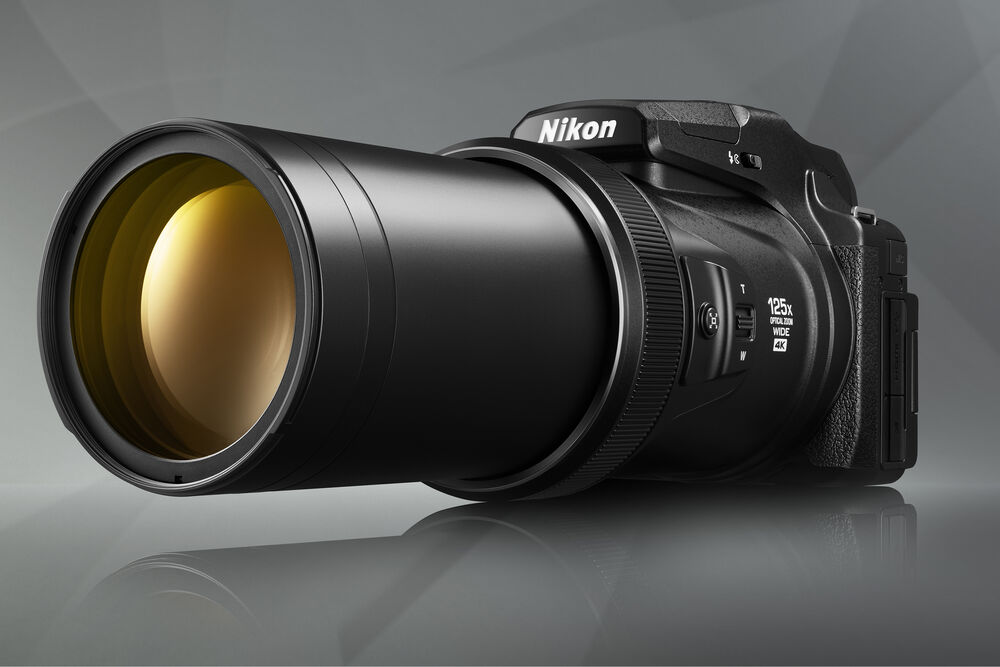
Shoot at staggering distances with the 125x optical zoom COOLPIX P1100 Digital Camera from Nikon. This camera has a 16MP backside illuminated CMOS sensor and features a built-in NIKKOR lens with a 35mm equivalent focal length range of 24-3000mm. You can zoom even further with 250x Dynamic Fine digital zoom, which gives you an equivalent focal length of 6000mm. Coupled with these extreme focal lengths is Nikon's Dual Detect Optical Vibration Reduction, which provides four stops of optical image stabilization, ensuring your telephoto shots are crisp and drastically reducing camera shake during handheld shooting.
Gracing the back of the camera is a 3.2" vari-angle, 921k-dot LCD monitor and an eye-level 2.36m-dot electronic viewfinder, so your subjects will always be easy to see. The camera is also capable of recording 4K UHD video at 30 fps and supports an external microphone via a 3.5mm connector.
16MP BSI CMOS Image Sensor
The backside-illuminated sensor with 16 million effective pixels can output detailed images at sensitivities between ISO 100 and 6400 and allows for captures in the newly introduced RAW (.NRW) format.
125x Optical Zoom with Dual Detect Optical Vibration Reduction
An absurd 24-3000mm (35mm equivalent) focal range means few, if any, objects are out of reach. Zoom is further enhanced by Dynamic Fine digital zoom, which makes the maximum focal length a ridiculous 6000mm. Dual Detect Optical Vibration Reduction provides four stops of optical image stabilization, so your handheld shots are crisp.
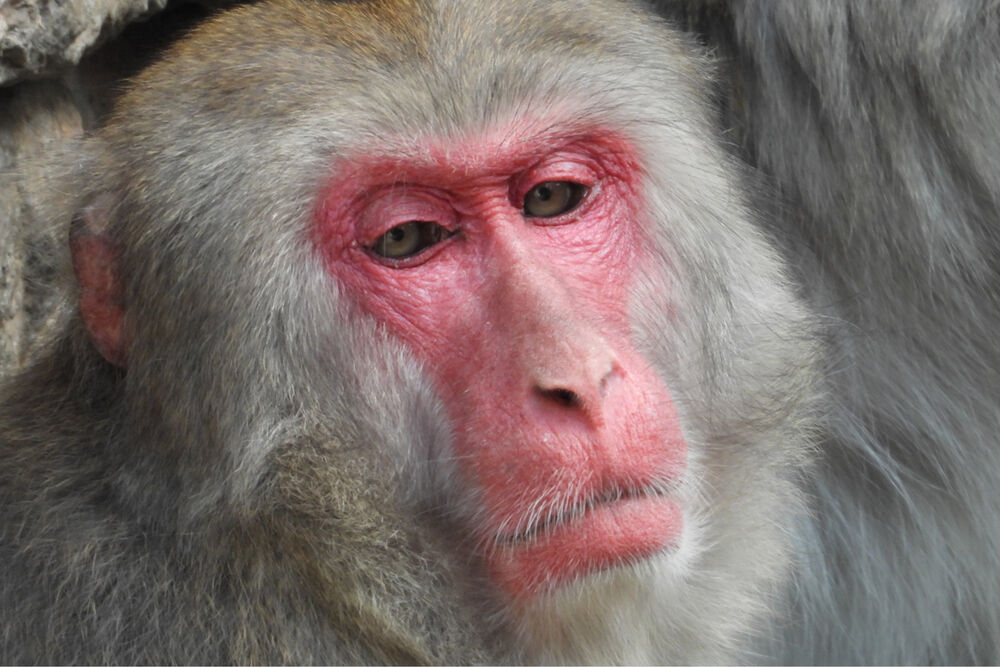
Video Capabilities
Support for UHD 4K movie at 30 fps allows you to record subjects with the power of super-telephoto 3000mm equivalent. Frames from movies recorded in this format can also be saved as still images. Additionally, this system supports Clean HDMI output, which cleans the information display from the image output to an external monitor during recording.
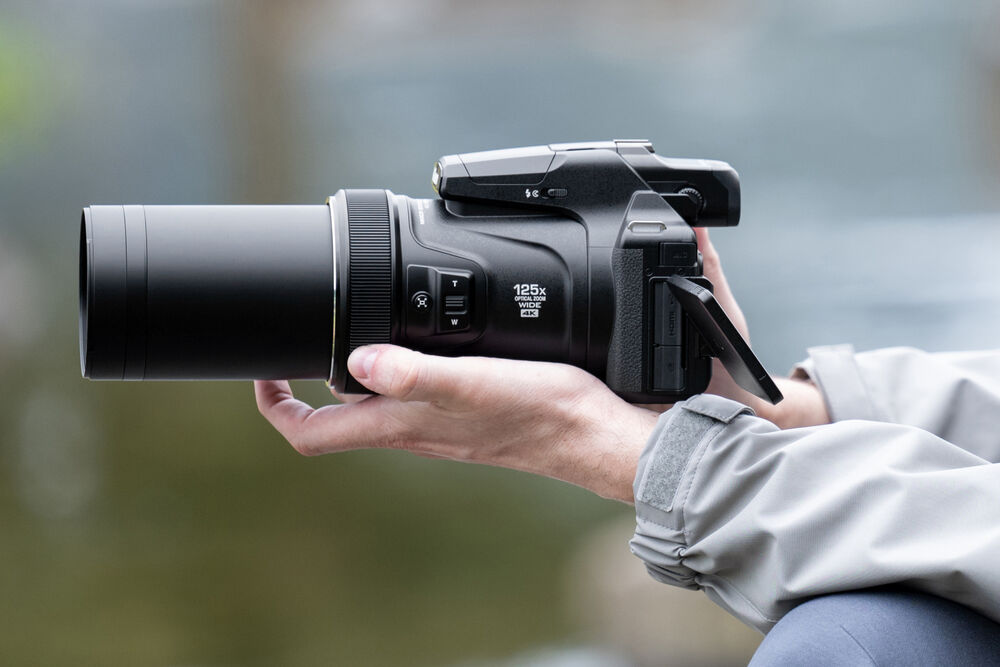
Dual Viewing Systems
The P1100 features a bright vari-angle 3.2" LCD display that makes composing and reviewing images and movies a breeze. Also available is the 0.39", 2.36 million-dot OLED electronic viewfinder for a more traditional shooting style.
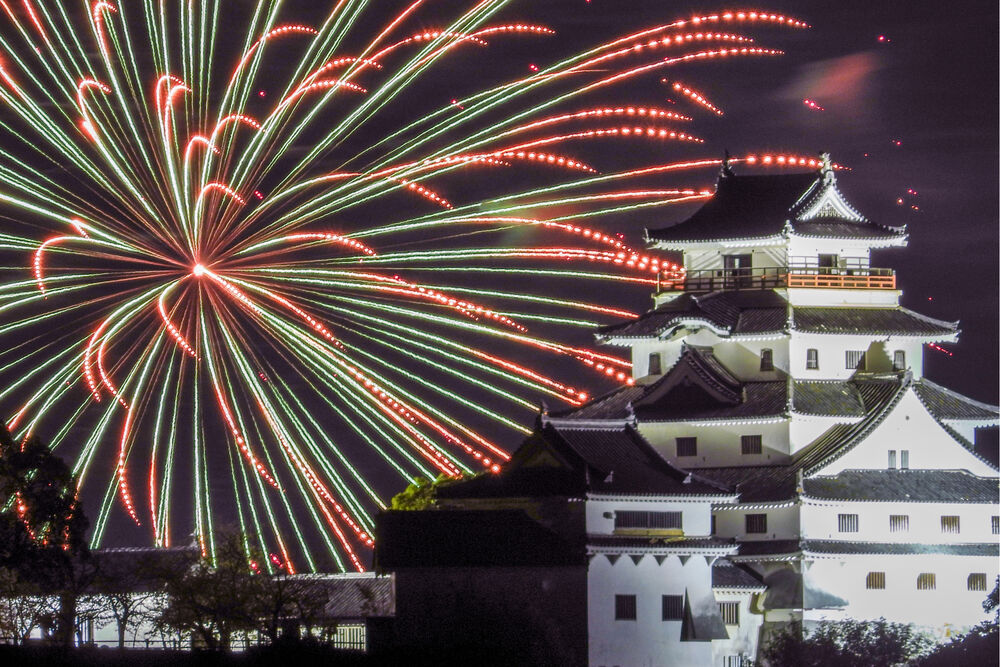
Shooting Modes
The P1100 features a slew of shooting modes that adjust settings for different scenarios like nightscape, light trails, star trails, and the new fireworks show. The popular Moon Mode is great for shooting Earth's closest neighbor and the Bird Mode optimizes the camera for capturing the often bright and colorful creatures, both accessible directly from the mode dial. Additionally, COOLPIX Picture Control allows adjustments in accordance with the subject, shooting situations, and intentions.
Control Ring and Snapback Button
Use the control ring at the front of the device for adjusting focus, exposure, white balance, and ISO, all from the lens barrel. Also on the barrel is a zoom toggle and a dedicated Snapback button that will make your P1100 quickly zoom out in case you lose sight of your subject at long focal lengths. Releasing the button will return the focal length to its previous position.
Built-In Wi-Fi and Bluetooth
Wireless connectivity has received significant upgrades, now operating under WPA3-SAE and Bluetooth version 5.1. Nikon's SnapBridge technology also allows for seamless photo sharing, and zoom control can be managed from a computer, smartphone, or tablet using NX Tether, or NX Field.
Optional ML-L7 Remote
The optional ML-L7 remote (not included) can wirelessly adjust a variety of settings such as ISO, zoom, and aperture, in addition to triggering the shutter of the P1100. This lets you maintain precise composition while shooting from a tripod.
Nikon ProStaff P7 10x30 Overview
Key Features
- Antireflective Lenses, Dielectric Prisms
- Oil/Water-Repellent Lens Coating
- Locking Diopter Saves Your Setting
- 346' Field of View
- Nitrogen Filled, Fog & Waterproof
- Closed-Bridge Configuration
- Reinforced Polycarbonate Chassis
- Large Center Focusing Knob
Compact for easy carry, the Nikon PROSTAFF P7 10x30 Binoculars deliver crisp views and stand up to the rigors of travel and trekking. The 10x magnification shows you details at a distance but is easy to hold steady. Multiple layers of antireflective and dielectric coatings on the prisms deliver sharp views with vivid colors, while a nonstick coating makes it easy to keep the objective and eyepiece lenses clean. You can lock in a customized diopter setting, which is helpful when friends or family members are also using the binocular. The PROSTAFF P7s are waterproof, fogproof, and drop resistant, so you can carry them confidently on your outdoor adventures. They measure less than 5" in length, so they won't take up much space in your gear bag.
Renowned Nikon Optics
P7 binoculars incorporate superior Nikon optics and lens coatings for a high-quality viewing experience.
Outstanding Clarity
Multilayer lens coatings cut glare and reflection for sharper, clearer views.
Higher Definition
Phase-correction coating is applied to the roof prisms for increased definition and clarity.
Brighter, Sharper Colors
Nikon's dielectric high-reflective multilayer prism coating maximizes light transmission across the visible range.
Locking Diopter Ring
Often reserved for the highest-end binoculars, the diopter ring locks into place so you can set it and forget it.
Eco-Friendly Glass
The glass used in PROSTAFF P7 binoculars is lead- and arsenic-free. Better for you. Better for the environment.
Nonstick Coating for Easy Cleaning
An oil- and water-repellent coating is applied to both the objective and eyepiece lenses. Simply wipe away moisture, fingerprints, and smudges.
Lenses That Won't Fog
The PROSTAFF P7s are filled with bone-dry nitrogen gas, so going from a warm car to the cold winter air won't fog the lenses.
Waterproof to 3.3'
Although they're not intended for underwater use, the PROSTAFF P7 binoculars can safely be used around splashing water or in inclement weather.
Turn-and-Slide Eyecups
Retract them for use with eyeglasses. Extend them to your ideal position for comfortable naked-eye viewing.
Long Eye Relief
The eye relief is 15.4mm to ensure everyone can find a clear, comfortable viewing position, with or without eyeglasses.
Tough-Skinned
The green rubber-armored body provides nonslip grip and protection from the occasional drop or bump.
Hard-Bodied
The lightweight body of the PROSTAFF P7 binoculars features strong fiberglass-reinforced polycarbonate resin.
Nikon D810 Overview
Key Features
- 36.3MP FX-Format CMOS Sensor
- EXPEED 4 Image Processor
- No Optical Low Pass Filter
- 3.2" 1,229k-Dot LCD Monitor
- Full HD 1080p Video at 60/30/24 fps
- Multi-CAM 3500FX 51-Point AF Sensor
- Native ISO 12800, Extended to ISO 51200
- 5-fps Shooting at Full Resolution
- Electronic Front Curtain Shutter
- 14-Bit RAW Files and 12-Bit RAW S Format
The Nikon D810 DSLR Camera takes its place as the high resolution option in the Nikon DSLR lineup. It features a 36.3MP FX-format CMOS sensor without an Optical Low Pass Filter for particularly sharp and detailed still imaging. With the addition of the EXPEED 4 Image Processor, performance speed is increased compared to the EXPEED 3 and noise is effectively reduced throughout the ISO range. Continuous shooting speed in FX format is 5 fps and in DX format hits a maximum of 7 fps. In addition, the Full HD video capabilities of the D810 have been upgraded to include 1080p capture at 24, 30 and 60 fps. Also, the improved efficiency of the processor enables up to 1200 shots on one battery charge and 40 minutes of video recording. Low light performance has been upgraded thanks to a wide native ISO sensitivity range that runs from 64 to 12,800 and can be expanded from 32 to 51,200.
The advanced Multi-CAM 3500FX autofocus sensor offers 51 AF points with 15 cross-type sensors and Group Area AF enables five AF sensors to be used as one group. This is useful when shooting subjects that cannot be tracked easily by one AF point due to lighting conditions.
As a camera optimized for video capture, the D810 features recording in both FX and DX formats including simultaneous recording to memory cards and an external recorder as well as recording 60p output to an external recorder. The ISO range for video has also been expanded to run from ISO 64 to 12,800 and expand to 51,200. Automatic ISO adjustment in manual mode enables smooth exposure transitions. A built-in stereo microphone is supported as are jacks for an external mic and headphones. A selectable audio frequency range provides exacting control over sound recording.
A 3.2" LCD with 1,229K-dot resolution provides playback viewing and live view, and improved coatings on the optical viewfinder components provide brighter images and more accurate colors. Live View function now includes split screen display zoom for stills, and zebra highlighting display in video mode. Full aperture metering during live view for still shooting is supported.
Interval and time-lapse shooting feature exposure smoothing, and the maximum number of images per sequence is now 9,999. Improved Picture Control settings now offer Flat Picture Control to enable maximum dynamic range and color adjustments in post-production.
The D810 utilizes dual media slots for both Compact Flash and SD cards, and it provides a built-in flash with i-TTL metering as well as a hot shoe mount. A larger grip enables comfortable control for extended shooting, and a secondary "i" button has been added to back panel for faster access to important settings.
36.3MP FX-Format CMOS Sensor without an Optical Low Pass Filter
Nikon's highest resolution sensor is housed in the D810, and by omitting the Optical Low Pass Filter, the sensor provides superior sharpness and detail. The sensor boasts fast channel readout, wide dynamic range, rich tones and improved imaging at high sensitivities.
EXPEED 4 Image Processor
The EXPEED 4 processor provides 30% faster performance over the EXPEED 3 as well improved low noise imaging throughout the ISO range. Support for 1080p video capture at 60 fps is featured and the processor's increased efficiency enables up to 1200 still shots and 40 minutes of video recording per charge.
Native ISO Range of 64 to 12,800
The improved ISO range compared to the D800 enables more effective low light imaging, and the ISO can be expanded from 32 to 51,200.
Advanced Multi-CAM 3500FX Auto Focus Sensor
Versatile AF Modes of 9, 21, and 51 points and 3D tracking enable fast, precise auto focus control. AF sensitivity down to -2 EV is effective in low light and 15 cross-type sensors are compatible with AF NIKKOR lenses with open aperture of f/5.6 or faster. Eleven central focus points work with an open aperture of f/8. Improvements include upgraded 'lock-on', expanded 'store by orientation,' and more options for AF mode restrictions.
Group Area AF
Group Area AF enhances subject detection and tracking in challenging lighting conditions or when shooting comparatively small subjects against a high-contrast background by grouping and monitoring 5 individual AF points. The 5-point AF area can be shifted across the 51-point array as your composition changes.
RAW Size S
Accelerate your workflow with Nikon's RAW Size S file format which delivers 12-bit uncompressed Nikon NEF files that enable faster image transfer and smoother post-production.
Continuous Shooting
In FX mode, the D810 can shoot up to 5 fps, and in DX mode it can capture up to 7 fps when utilizing the MB-D12 battery grip with AA batteries.
Reduced Vibration for Sharper Imaging
The D810's shutter/mirror box architecture and electronic front-curtain feature improve overall image clarity. The shutter/mirror mechanism reduces image shake for a steady viewfinder image with minimal blackout during high-speed shooting. When activated, the electronic front-curtain shutter reduces the risk of blur in even subtle details by minimizing internal vibrations during exposure.
Quiet Continuous Mode
A redesigned Sequencer/Balancer Mechanism enables Quiet Continuous Mode for near silent sequential shooting.
Picture Control
In addition to standard, neutral, vivid, monochrome, portrait and landscape, image control options have been expanded to include Flat Picture Control which is geared for shooting in RAW modes and for video capture when adjustments will be made in post-production. Also, a clarity option has been added to all Picture Control settings and better control over Picture Control is enabled by fine 0.25 steps.
Full HD 1080p Video Capture in 60/30/24 fps
Video recording is supported in both FX and DX formats with an ISO range from 64 to 12,800 and expandable to 51, 200. Simultaneous recording to memory cards and to an external recorder is now supported. Auto ISO adjustment is possible in manual mode for smooth exposure transitions. Nikon's 3D noise reduction reduces random noise, distortion, and flicker when filming at high sensitivities. Zebra mode on the camera monitor shows you exactly where highlights are. A built-in stereo microphone as well as jacks for external microphone and headphones are provided. You can fine-tune audio levels in isolation both before and during recording and select the sound range (wide/voice).
3.2" LCD Monitor with 1,229k-dot Resolution
A high resolution LCD provides detailed playback viewing and live view capture with color balance and brightness control. A split screen display zoom for still shooting lets you compare two enlarged points in the image for sharpness and exposure.
Optical Viewfinder
Improved coatings on the optical components render brighter and more accurate color, and the Organic EL information display makes it easier to make adjustments under bright/dim conditions.
Interval Timer/Time-Lapse Shooting
Exposure smoothing is supported in time-lapse and interval shooting modes and the number of recordable images has been increased to 9,999.
Flash
Both a built-in flash and hot shoe mount are supported with i-TTL metering, as is a flash sync terminal. The built-in flash offers commander mode for wireless control of up to two groups of off-camera flash units.
CF and SD Card Slots
Two card slots are supported for versatile image storage and smoother workflow. One CF card slot for high-speed UDMA 7 cards, and one SD card slot for high-speed, high-capacity SDXC and UHS-I cards allow you to use one card as back-up or place still images on one card and video on the other or RAW on one and JPEG on the other.
Wi-Fi with Optional Transmitter
The D810 offers wireless connectivity for image transfer to a computer or FTP server and for remote camera control using Nikon's Camera Control Pro 2 software via the optional WT-5A Wireless Transmitter in combination with the optional UT-1 Communications Unit. The WT-5 attaches to the UT-1 unit which mounts to the camera's accessory hot shoe.
Form Factor
A deeper hand grip improves handling, and a secondary "i" button has been added for easier access to important settings. A durable magnesium alloy body with extensive weather and dust sealing ensure the D810 is moisture- and dust-resistant.
Nikon Z50 II Overview
Key Features
- 20.9MP DX-Format CMOS Sensor
- EXPEED 7 Image Processor
- UHD 4K60p/Full HD 120fps Video Recording
- Improved Autofocus, 9 Subject Detection
- Dedicated Picture Control Button
- Pre-Release Capture, 30 fps Shooting
- Bright OLED Electronic Viewfinder
- 3.2" 180° Tilting Touchscreen
- SD Memory Card Slot
- Built-In Wi-Fi and Bluetooth
A powerful yet compact mirrorless system made for rising creators, the Nikon Z50 II Mirrorless Camera combines a 20.9MP APS-C CMOS sensor and an interchangeable lens mount with a host of flagship features and compatibility with the entire NIKKOR Z lens lineup to elevate your content beyond the smartphone.
20.9MP DX-Format CMOS Sensor & EXPEED 7 Image Processor
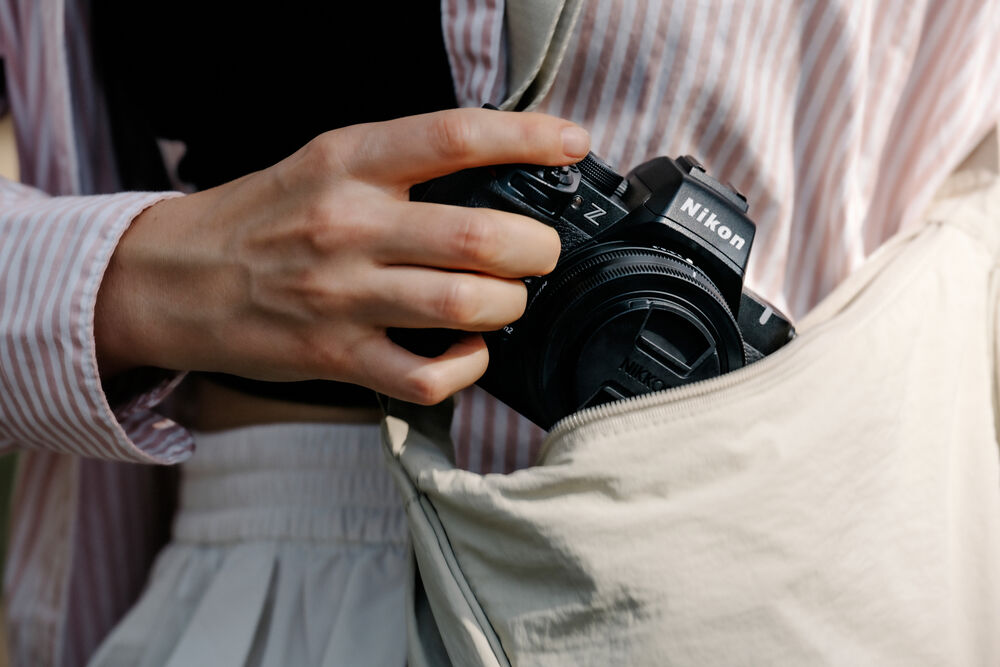
The DX-format 20.9MP CMOS sensor is paired with the same EXPEED 7 image-processing engine found in its flagship, full-frame brethren to provide a versatile mixture of high sensitivity, nuanced image quality, fast, AI-powered autofocus, and full-resolution continuous shooting up to 30 fps. At native values, a sensitivity range from ISO 100-51200 permits working in a broad array of lighting conditions, and can be further expanded up to ISO 204800 for extreme low-light conditions. The mixture of resolution and sensor size also contributes to clean image quality and smooth color transitions with reduced noise throughout the sensitivity range.
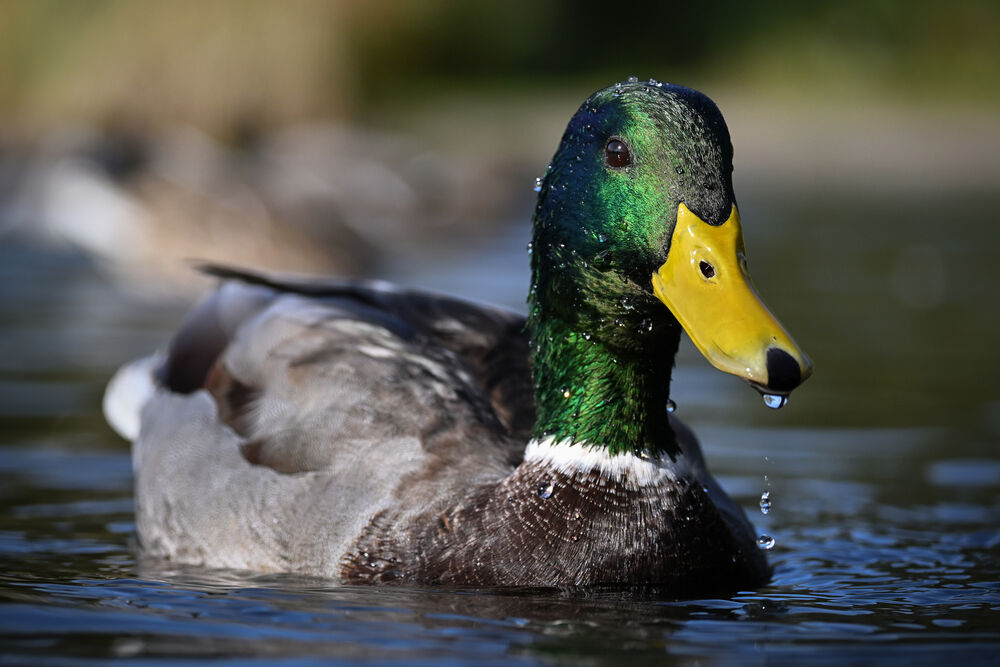
Nikon's Most Advanced Autofocus
Using inherited algorithms and deep learning technology from the Z9, including sophisticated Subject Detection for nine different subject types, the Z50 II can recognize a variety of distinct subject types, ranging from humans to animals to airplanes to bicycles. The popular dedicated Bird Detection mode is also featured. When working in Auto-Area AF, these subjects will automatically be detected, focused on, and tracked to ensure sharp focus when the subject is moving across the frame.
Eye-Detection AF, specifically, has been tuned for improved accuracy and refined recognition of eyes in the scene and can also be used in conjunction with custom Wide-Area AF for different subject shapes and sizes.
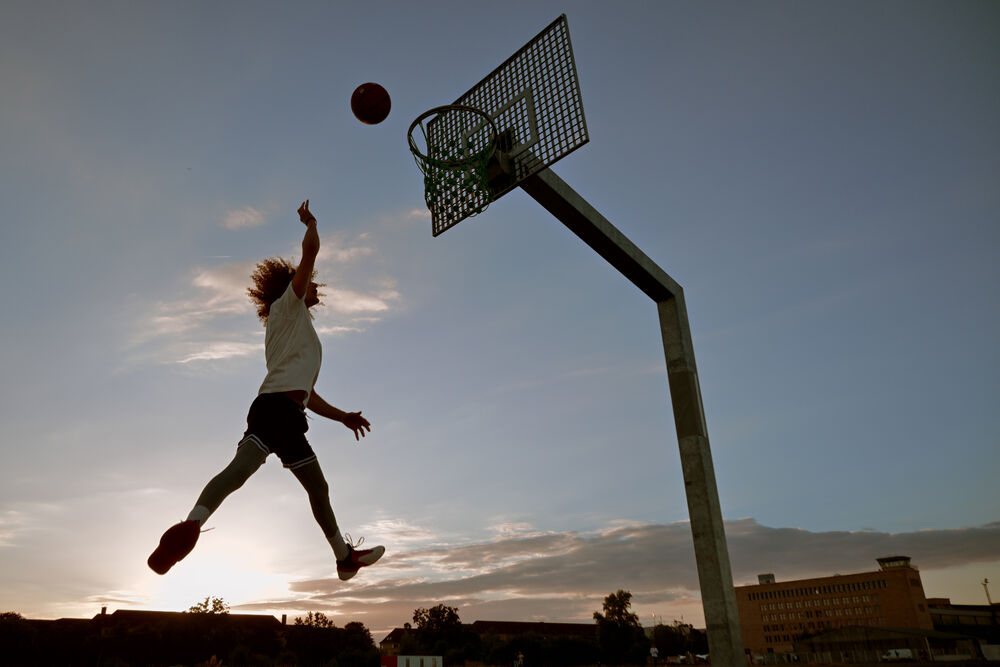
Pre-Release Capture
The EXPEED 7 processor also unlocks Pre-Release Capture, a feature that helps make decisive moment shots easier by recording frames in a burst for up to a second prior to actually releasing the shutter. When this feature is activated, burst shooting will commence when the shutter is half-pressed, and the buffer will retain the frames after fully pressing the shutter.
UHD 4K Video Recording

Capable of recording more than just stills, the Z50 II has improved its video capture abilities as well, now supporting UHD 4K video recording up to 60 fps and Full HD recording up to 120 fps along with a Product Review mode, recording time limits up to two hours, a video self-timer feature, built-in electronic Vibration Reduction, and the ability to save movie files to the in-camera memory cards or an optional external recorder via HDMI out. In-camera time-lapse shooting is also possible with the ability to produce a finished UHD 4K video file directly from the camera.
A first for Nikon, the Z50 II is UAC and UAV compliant for live web-streaming. Additionally, you can now record 10-bit video internally with Nikon's N-Log LUT and use four new RED LUTs as well.
Color Control for Creators

Nikon has added a Picture Control button atop the Z50 II to make access to its 31 built-in presets available even in Auto mode. The color presets can now be overlaid in the rear LCD screen, giving you the ability to visualize the color shifts as you create. Creator Recipes built by fellow Nikon shooters are available through the Nikon Imaging Cloud and can be downloaded and integrated alongside the presets. Additionally, Nikon provides a one-year subscription to their Cloud Picture Controls software, so you can use your own presets with professional editing tools.
Body Design and Connectivity

- A large 3.2" LCD touchscreen is available for bright, clear, and vivid image playback and live view shooting. The screen has a 180° flip-under tilting design, which benefits front-facing selfie captures, and offers more intuitive operation, navigation, and settings control. The upgraded touchscreen now features the Touch FN option, which allows you to select the focus point with your fingertips.
- The improved electronic viewfinder was redesigned for increased comfort in eye-level viewing. Using NIKKOR optics to guarantee a sharp, clear image, it is now twice as bright as its predecessor.
- A built-in flash and a hot shoe allow you to introduce additional light into low-lit scenes, with a dedicated Night Portrait mode that optimizes a balanced exposure with available and additional light.
- A headphone jack has been added, doubling as a terminal for Nikon's newly released and optional MC-DC3 Remote Release Cord, and the USB-C terminal provides both camera charging and USB power delivery. The camera retains the microphone and HDMI ports of its predecessor.
- Built-in SnapBridge connectivity enables seamless transfer of low-resolution imagery as well as remote shooting capabilities. BLE (Bluetooth Low Energy) and Wi-Fi enable communication between the camera and a smart device, and the mobile device can remotely trigger the shutter to display a live view image from the camera for working from a distance.
- The included EN-EL25a rechargeable lithium-ion battery extends camera battery life, with in-camera charging also supported.
- Single SD memory card slots supports the UHS-II protocol for quickly storing photo and video files.

Nikon 1526 Overview
Key Features
- 16.2MP FX-Format CMOS Sensor
- EXPEED 3 Image Processor
- 3.2" 921k-Dot LCD Monitor
- Dedicated Still Image Only Camera
- Multi-CAM 4800 39-Point AF Sensor
- Native ISO 12800, Extended to ISO 204800
- 5.5 fps Shooting at Full Resolution
- Mechanical Exposure Control Dials
- Compatible with AI and Non-AI Lenses
- Rugged Magnesium Alloy Body
The silver Nikon Df DSLR Camera revolves around a unique manual and mechanical design that champions a simple and intuitive method of working, while still retaining the highest imaging quality and functionality available. Featuring a full-frame, FX-format 16.2MP CMOS sensor and EXPEED 3 image processor, the Df is capable of producing high-resolution, well-detailed still imagery with exceptional color rendition, tonal gradation, and highlight and shadow detail. A notable low-light sensitivity range of ISO 100-12800 can be further expanded to ISO 50-204800 for challenging lighting conditions and a top continuous shooting rate of 5.5 fps aids in working with fast-moving subject matter.
The manually-configurable design of the Df blends a timeless control scheme with contemporary precision to enable simple and direct handling of all exposure features of the camera. Utilizing dedicated shutter speed, exposure compensation, ISO sensitivity, exposure mode, and release mode dials, efficient control is possible without needing to delve into a complex menu structure. For viewing, both an optical glass pentaprism viewfinder and 3.2" 921k-dot LCD monitor are housed within the magnesium alloy body design. When using the LCD for live view shooting, the image can be magnified up to 19x for critical focus and a fast contrast-detection focusing method is used. Both a hot shoe and flash sync terminal are integrated into the body's design, too, as well as a unique mount system that employs a metering coupling lever to enable the use of both AI and non-AI lenses for extensive support of NIKKOR lenses from the past and present.
When working with the optical viewfinder, the Multi-CAM 4800 AF system is used and employs 39 points about the frame, with nine cross-type points for added accuracy when photographing in more difficult light. Seven centrally-located sensors are also compatible with f/8 or faster lenses, which greatly enhances the autofocus performance when working with longer, telephoto lenses used in combination with teleconverters.
Accurate exposure metering is done using a 2,016-pixel RGB sensor and Nikon's Scene Recognition System, which automatically analyzes all aspects within a scene, including brightness, contrast, and color, and compares these values to an on-board database in order to determine an appropriate exposure value that is consistent from image to image. White balance, autofocus, and i-TTL flash metering also use this system and, additionally, the Spot White Balance feature can be used in live view for pin-point selection of a white area within the scene to deliver true color balance. Built-in HDR and Active D-Lighting can be used to extend the apparent dynamic range of a scene and Picture Control settings can be applied to refine the overall look and feel of colors and contrast in-camera.
Timeless Design with Contemporary Performance
Separating itself from other DSLRs, the Df revolves around a classically-inspired design that employs a manual control scheme and a pared-down interface to inspire a more intuitive and efficient method of working. As a still image-only camera, key design elements cater to the needs of a photographer, including dedicated mechanical dials for shutter speed, ISO sensitivity, exposure compensation, exposure mode, and release mode control as well as the incorporation of a bright pentaprism viewfinder, cable release socket, hot shoe, and flash sync terminal. The magnesium alloy body also houses a large 3.2" 921k-dot LCD monitor, which can be used for live view monitoring, image playback, and menu navigation.
A unique lens mount system has also been developed and integrates a metering coupling lever to enable the use of both AI (Aperture Index) and non-AI lenses. This means that in addition to supporting current AF-S, AF-D, and AF NIKKOR lenses, past manual focus, non-AI lenses can also be used without any modification necessary.
16.2MP FX-Format Sensor and EXPEED 3 Image Processor
The 16.2 megapixel full-frame (FX) CMOS sensor and EXPEED 3 image processor work in tandem to produce overall high image quality with notable detail, dynamic range, color accuracy, and low-light sensitivity to a native ISO 12800, which is further expandable to ISO 204800. This still image-only camera is also well-suited to working with moving subject matter with a top 5.5 fps continuous shooting rate using either the viewfinder or when working in live view.
39-Point Multi-CAM 4800 AF Sensor
Benefitting the exceptional image quality is an apt AF system that employs 39 distinct AF points, including nine cross-type sensors, to quickly acquire focus in a range of lighting conditions, from -1 to +19 EV. An intelligent Scene Recognition System, typically reserved for exposure metering, benefits the focusing performance by analyzing and identifying subjects to suit panning and tracking-based shooting styles. Depending on the situation, 9, 21, or 39 point arrays can be selected from and seven centrally-located points are compatible with f/8 or faster lenses, extending the auto focusing abilities of the longest lenses used in conjunction with teleconverters. When using this phase-detection focusing method, selectable AF-area modes include: Single-point AF mode, Dynamic-area AF mode, 3D-tracking mode, and Auto-area AF mode.
When working in live view, a contrast-based AF system is employed to acquire focus precisely and can function in continuous, full-time servo mode to better-suit working with moving subjects. Four distinct AF-area modes are available when using the contrast-detection focusing method: Face-priority AF, Wide-area AF, Normal-area AF, and Subject-tracking AF. Additionally, benefitting working with manual focus when in live view, the image can be magnified up to 19x for critical examination and easier focus confirmation.
Scene Recognition System
The intelligent Scene Recognition System with 3D Color Matrix Metering II utilizes a 2,016-pixel RGB sensor to evaluate and analyze all aspects within a scene, including brightness, contrast, subject distance, and the scene colors, to quickly determine an accurate exposure and white balance setting to best render the scene at hand. The information gathered is also checked against onboard reference images to ensure consistency from image to image in regard to exposure, white balance, i-TTL flash settings, and subject-tracking AF performance.
Other Camera Features
- Picture Control modes can be directly accessed via a dedicated button and allow you to set predefined looks to imagery in-camera, and include Landscape, Monochrome, Neutral, Portrait, Standard, Vivid, and user-customizable settings.
- Active D-Lighting helps to preserve both highlight and shadow details when working in contrast-rich scenarios, such as backlit lighting. Utilizing the EXPEED 3's processing power, a more controlled image will be produced with brightness values closer to how they are naturally seen. This mode is suitable for working with moving subjects.
- Built-in HDR works to extend the tonal and exposure range of a single image by recording two separate exposures and blending them together in order to gain greater highlight and shadow details with an extended range of mid-tones. The smoothness of the edge where the two separate exposures meet can be adjusted for more apparent softness to benefit images with a greater range of encompassed exposure values. This mode is best suited for working with stationary subjects.
- The accessory terminal supports the use of the optional WU-1a Wireless Mobile Adapter to enable remote, instant transferring of photos to Android and iOS mobile devices for sharing online. The GP-1A GPS Unit is also supported, which automatically adds locational information to images' metadata for geotagging applications.
- Spot White Balance enables precise, selective control of the white balance setting by simply pointing and metering a pure white portion of the scene in order to set the proper color balance when working in live view.
- One memory card slot is available and accepts SD, SDHC, and SDXC type memory cards, including UHS-I SDHC and SDXC cards.
- An in-camera virtual horizon can detect both rolling (horizontal inclination) and pitching (forward or rear inclination) directions and display an electronic level on the LCD when working in live view. The rolling direction of tilt can also be displayed within the viewfinder.
- Supported languages: Arabic, Chinese (Simplified and Traditional), Czech, Danish, Dutch, English, Finnish, French, German, Indonesian, Italian, Japanese, Korean, Norwegian, Polish, Portuguese, Romanian, Russian, Spanish, Swedish, Thai, Turkish, and Ukrainian.

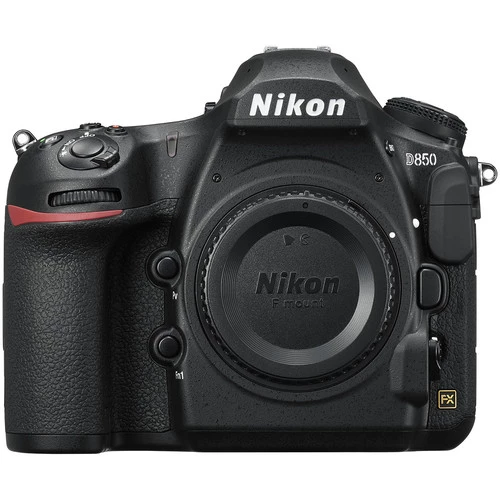
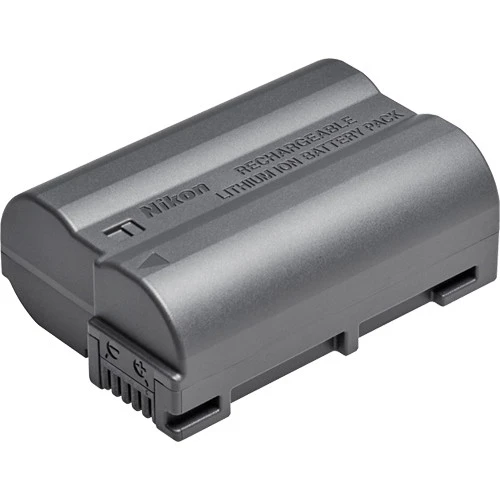
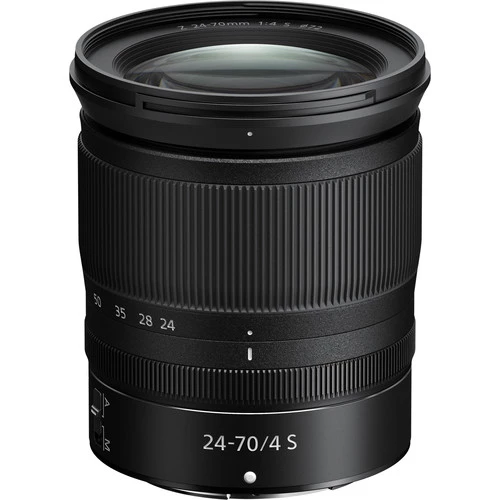
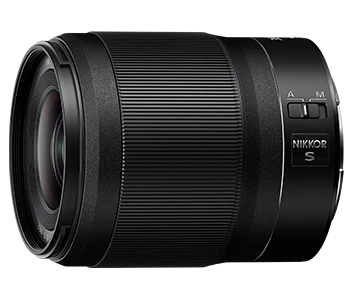
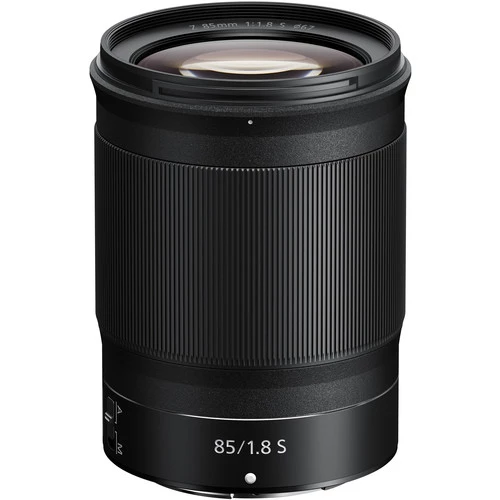
 (1).webp)
.webp)
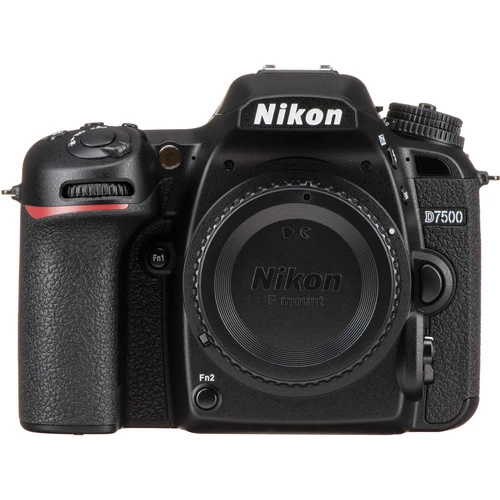
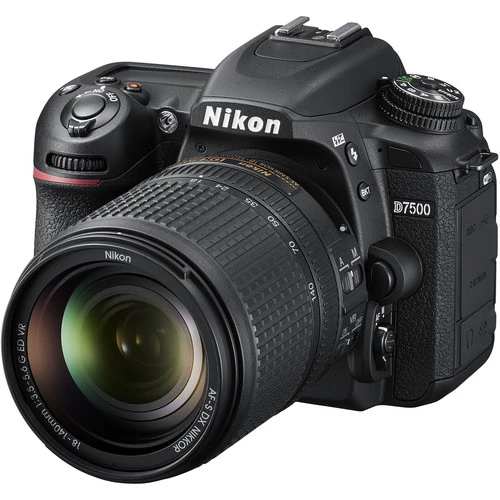
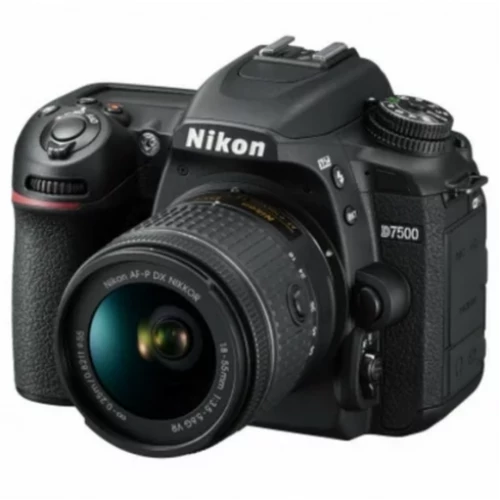
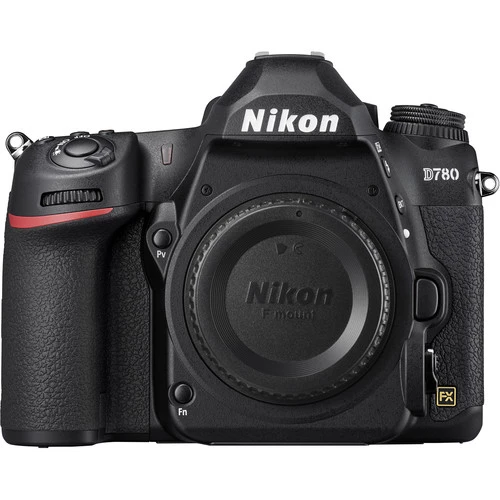
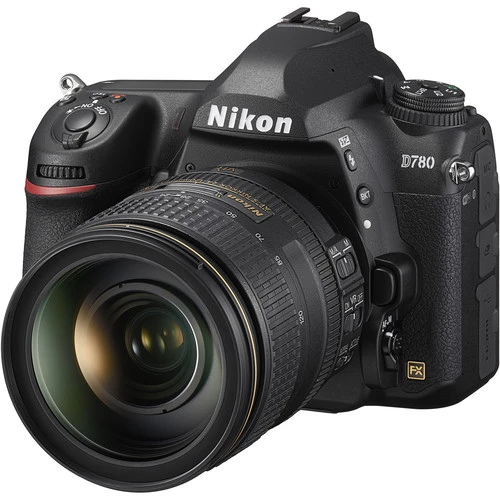
.webp)
